EM-3 Electron Diffraction & Phase Contrast I
电子散射原理
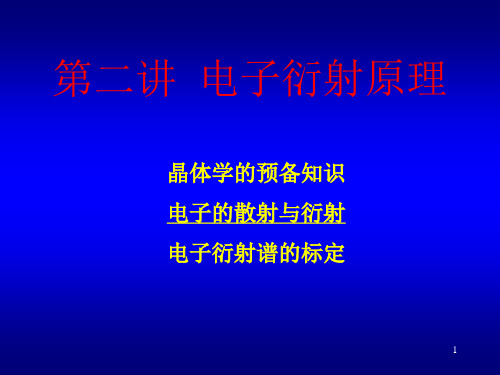
– 这种方法克服了衍射与所选区域不对应的问题 – 电子衍射斑的分裂特征揭示畴结构的界面结构
➢ 慢扫描CCD设备的发展和能量过滤系统
的完善,开始了定量电子衍射的分析
2
电子的散射和衍射
X-ray衍射和电子衍射比较
❖小区域分析,并与显微放大像对照
➢X-ray难于汇聚, 毫米,亚毫米量级 ➢电子束斑容易会聚,在微米、纳米量级
➢ 假设衍射束远远小于入射束,即在运动学条件下进 行讨论。
➢ 运动学基本假设实现:电子只被晶体散射一次,不 考虑多次衍射效应。
6
Fresnel衍射
❖Fresnel衍射是一种近场衍射。
❖Fresnel近似的本质就是在近光轴区域用 抛物面形的电子波代替球面波。
(
x,
y)
i
2
q(
X
,Y
)
exp(2ikr)
➢ 注意散射和衍射的本质和区别,在不同情况下,我们将根据习惯而
分别使用这两个术语。
5
电子的散射和衍射
电子衍射的几何原理和运动学理论
➢ 与X 射线衍射相似,晶体中有序排列的原子及原子 面间距可以看成干扰电子波传播的物体和狭缝,利 用极薄的晶体样品,可以获得电子衍射的实验数据。
➢ 为了很好地解释显微镜图像和电子衍射谱,需要透 彻地分析决定B
1
1 v2
c2
1
m c2 2 0
1 v2 c2
m2c2
p2
h
2em 0
eV
1
2
eV mc
0
2
V
1
12.26856 0.97789
10
6
V
Å
h
2eV m m 0
欧盟残余应力标准EN153 05中文翻译稿
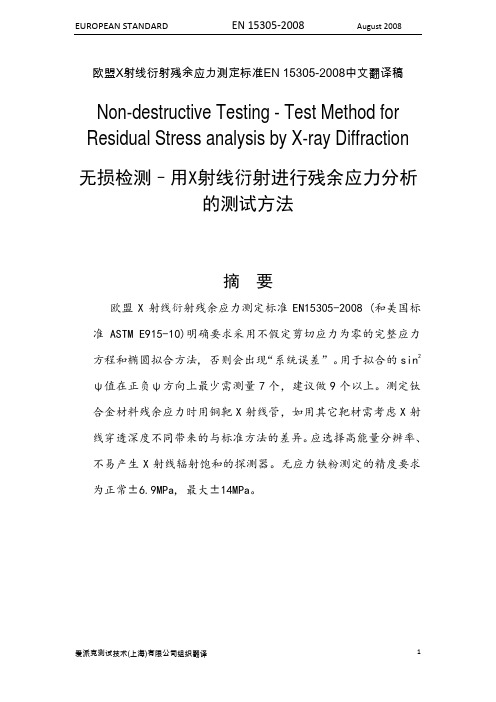
EUROPEAN COMMITTEE FOR STANDARDIZATION COMITE EUROEEN DE NORMALISATION EUROPAISCHES KOMITEE FUR NORMUNG
爱派克测试技术(上海)有限公司组织翻译
2
EUROPEAN STANDARD
EN 15305‐2008
EUROPEAN STANDARD
EN 15305‐2008
August 2008
欧盟X射线衍射残余应力测定标准EN 15305-2008中文翻译稿
Non-destructive Testing - Test Method for Residual Stress analysis by X-ray Diffraction
爱派克测试技术(上海)有限公司组织翻译
1
EUROPEAN STANDARD
EN 15305‐2008
August 2008
ICS 19.100
无损检测–用X射线衍射进行残余应力分析 的测试方法
本欧洲标准于2008年7月4日经欧盟标准委员会(CEN)批准。
欧盟标准委员会成员国有义务按照欧盟标准无变更的给予标准国家地位。关于本 标准的最新目录和题录都可从欧盟标准委员会管理中心和欧盟成员国那里得到。
6.2.3 χ 法....................................................... 22
6.2.4 修改的 χ 方法............................................... 23
6.2.5 6.3 6.4 6.5
其它衍射几何............................................... 23 辐射的选择 ................................................. 23 探测器的选择 ............................................... 26 设备的性能 ................................................. 26
透射电镜的选区电子衍射
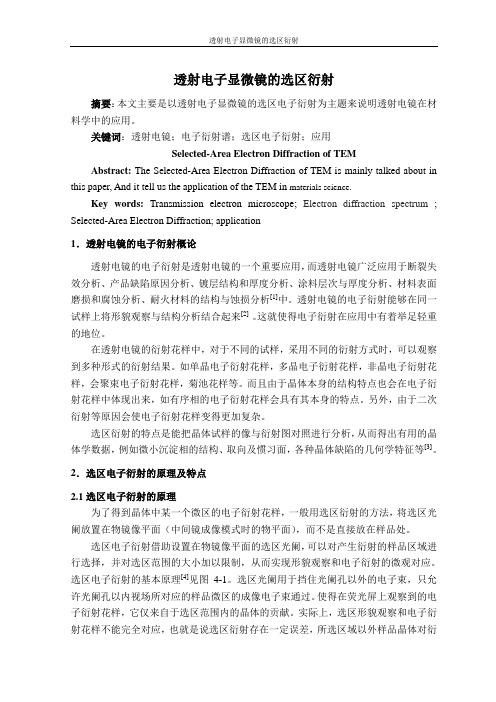
透射电子显微镜的选区衍射摘要:本文主要是以透射电子显微镜的选区电子衍射为主题来说明透射电镜在材料学中的应用。
关键词:透射电镜;电子衍射谱;选区电子衍射;应用Selected-Area Electron Diffraction of TEMAbstract: The Selected-Area Electron Diffraction of TEM is mainly talked about in this paper, And it tell us the application of the TEM in materials science.Key words:Transmission electron microscope; Electron diffraction spectrum; Selected-Area Electron Diffraction; application1.透射电镜的电子衍射概论透射电镜的电子衍射是透射电镜的一个重要应用,而透射电镜广泛应用于断裂失效分析、产品缺陷原因分析、镀层结构和厚度分析、涂料层次与厚度分析、材料表面磨损和腐蚀分析、耐火材料的结构与蚀损分析[1]中。
透射电镜的电子衍射能够在同一试样上将形貌观察与结构分析结合起来[2]。
这就使得电子衍射在应用中有着举足轻重的地位。
在透射电镜的衍射花样中,对于不同的试样,采用不同的衍射方式时,可以观察到多种形式的衍射结果。
如单晶电子衍射花样,多晶电子衍射花样,非晶电子衍射花样,会聚束电子衍射花样,菊池花样等。
而且由于晶体本身的结构特点也会在电子衍射花样中体现出来,如有序相的电子衍射花样会具有其本身的特点。
另外,由于二次衍射等原因会使电子衍射花样变得更加复杂。
选区衍射的特点是能把晶体试样的像与衍射图对照进行分析,从而得出有用的晶体学数据,例如微小沉淀相的结构、取向及惯习面,各种晶体缺陷的几何学特征等[3]。
2.选区电子衍射的原理及特点2.1选区电子衍射的原理为了得到晶体中某一个微区的电子衍射花样,一般用选区衍射的方法,将选区光阑放置在物镜像平面(中间镜成像模式时的物平面),而不是直接放在样品处。
液相法制备MoO3纳米结构

液相法制备MoO3纳米结构摘要“纳米”是一个长度单位,1纳米是1米的十亿分之一(1nm=10-9m)相当于头发丝直径的十万分之一。
纳米材料指的是晶粒尺寸为纳米级(10-9m)的超细材料。
纳米材料由于具有与块体材料不同的尺寸效应、体积效应、表面界面效应和宏观量子隧道效应等,使其在电子信息、化工、生物工程、医药、航空航天、国防等高尖端领域有着广泛的应用前景。
纳米材料既是一种新材料又是构成新材料的重要原料。
钼和钼合金材料不仅具有良好的耐高温强度和硬度,而且具有良好的导电、导热、抗腐蚀等性能,此广泛应用于化学化工、冶金机械及航空航天等工业领域。
三氧化钼( MoO3) 不仅是制备钼和钼合金材料的主要原料,而且本身也具有电致变色、光致变色、光催化降解及气敏等特性,因此在合成敏感元件、催化剂、快离子导体及潜在的电池电极等许多功能材料方面具有特殊用途。
制备性能优异的三氧化钼薄膜一直是研究的重点。
近年来,随着科学技术的进步,不断出现许多新型的三氧化钼薄膜制备方法。
目前已有多种制备Mo O3薄膜的方法,如蒸镀法、电化学沉积法、溅射法、溶胶-凝胶法等。
本文主要从沉淀法,水热法,化学气象沉积法,溶胶凝胶法等工艺流程来阐述MoO3的制备。
关键词:纳米,三氧化钼,液相法,纳米薄膜,钼合金材料THE LIQUID PHASE PREPARATION OF NANO MoO3ABSTR ACT"N ano" is a un it o f len gth,1nano meter is o ne hu nd red b illio nt h o f a meter (1nm =10-9 m),and it is eq u ivale nt to o ne o ver o nehu nd red tho usand the d ia meter o f a hair.Nano materia l refers to the grain size fo r the nano meter leve l (10-9m) o f sup er fine mater ia l. Because o f N ano materia ls have d ifferent size effect, sur face effect, vo lu me inter face effect and macro sco p ical q uant u m t un nel e ffect etc, when co mp ared wit h b u lk materia ls,mak in g N ano materia ls have a wid e range o f app licat io ns in electro n ic in fo rmat io n ind ustry, chemica l ind ustry,b io lo g ical en g ineerin g,med icine,aviat io n,fro nt ier defe nse etc. N ano materia l is no t o nly a k ind o f new mater ia l b ut also an imp o rtant raw materia l o f the new materia l.Mo lyb d enu m and mo lyb den u m allo y materia l no t o n ly has go o d resista nce to hig h temp erature and go o d hard ness strengt h,b ut also has goo d electr ic co nd uct iv ity,ther mal co nd uct iv ity,co rro sio n resista nce and o ther p rop erties,they are wid e ly used in chemica lind ustry,meta llurg y mecha n ical ,aero sp ace and o ther ind ustries. Three mo lyb den u m o x id e (MoO3) is no t o n ly the ma in raw mater ial tomak e mo lyb d enu m and mo lyb d enu m allo y mater ial,meanw h ile it a lso has the effect o f electro chro mic,p ho to chro mic,p ho to catalyt ic degrad atio n and characterist ics o f air sensit ive,what’s mo re,it has sp ecial use in man y funct io na l materia ls w ith d ifferentp urpo ses ,such as the synt hesis o f sens it ive co mp o nents,c atalyst,fast io n,and battery electrod es etc.The man ufacture o f t hree mo lyb den u m o x id e film w it h o utstand ing p erfo r mance has b eco me t he fo cus o f recent research.In recent years, w ith the deve lo p ment o f scient ific techno lo g y, d ifferent metho d s o f mak in g three mo lyb d enu m o x id e film app ear.Recent ly, there exists a variet y o f p rep aratio n MoO3film metho d s, such as steamed p latin g metho d, electro chemica l depo sit io n metho d, sp utter in g,so l-gel,etc. Th is artic le exp lains the p rep aratio n o f MoO3 ma in ly fro m the p ro cess o f p recip itat io n,h yd ro therma l sy nthes is, chemica l meteo ro lo g ical d epo sit io n met ho d.K EY WO RDS:nano,MoO3,liq u id p hase,mo lyb d enu m a llo y目录第一章前言 (5)§1.1纳米材料 (5)§1.1.1 纳米材料概念 (5)§1.1.2 纳米材料的结构与性能 (5)§1.2 M O O3的结构和性质 (6)§1.3 M oO3发展现状 (7)§1.3.1 纳米线/纳米棒(na no w ir e/n an or o d) (7)§1.3.2 纳米带(na no be l t/na n or ib b on) (8)§1.3.3 纳米管(na no tu b e) (8)纳米材第二章液相法制备M nO3料 (10)§ 2.1沉淀法 (11)§2.2水热法 (15)§2.2.1 无模板水热结晶法 (16)§2.2模版水热法 (19)§2.2.1 软模板水热法 (19)§2.2.2 软模板与无模板水热的比较: (22)§2.2.3硬模板水热法: (23)§2.3溶胶一凝胶流程 (24)§2.3.2 钼酸溶胶 (27)§2.4化学气相沉积法(C V D法) (28)的结构与性能 (31)第三章Mo O3§3.1 M oO3的相结构 (31)§3.2 M oO3的形貌: (32)§3.3 M o03的性能 (33)§3.3.1.电致变色及其应用 (33)§3.3.2抑烟一阻燃性及其应用 (34)§3.3.3 催化性能及其应用 (35)§3.3.4 气敏性能 (36)第四章结论和展望 (38)第一章前言1.1 纳米材料1.1.1纳米材料概念在20世纪60年代,著名的诺贝尔奖获得者F eyne man【1】曾预言:如果我们对物体微小规模上的排列作某种控制,我们就能使物体得到大量异常的特性,看到材料的性能产生丰富的变化。
红色荧光粉CaWO4∶Eu3+,Bi3+的制备和光学性能的研究

第53卷第5期2024年5月人㊀工㊀晶㊀体㊀学㊀报JOURNAL OF SYNTHETIC CRYSTALS Vol.53㊀No.5May,2024红色荧光粉CaWO 4ʒEu 3+,Bi 3+的制备和光学性能的研究蔡小勇1,姜洪喜1,2(1.黑龙江科技大学研究生学院,哈尔滨㊀150022;2.嘉应学院,梅州㊀514015)摘要:本文采用高温固相法合成了一系列红色荧光粉CaWO 4ʒEu 3+,Bi 3+㊂通过X 射线衍射仪㊁扫描电子显微镜和荧光分光光度计等手段,对样品的晶体结构㊁微观形貌㊁光学性能㊁能量传递方式㊁荧光寿命和热稳定性进行了表征㊂结果表明,当Eu 3+和Bi 3+的掺杂浓度分别为7%和2%时(摩尔分数),荧光粉红色发光(615nm)最强,理论计算得到荧光粉的平均颗粒尺寸为50.27nm,这与电子显微镜观察结果相符合㊂能量传递方式以电偶极-电四极相互作用为主,对CaWO 4ʒ7%Eu 3+,y Bi 3+(y =0~6%)系列荧光粉进行了荧光寿命测量,发现它们荧光寿命基本相同,都在0.56ms 左右㊂对CaWO 4ʒ7%Eu 3+,2%Bi 3+荧光粉在不同温度下的光谱进行比较,并且计算相应的色度坐标,当温度升高时,色度坐标整体左移,发光强度有所变弱,但整体来说热稳定性较好㊂较好的热稳定性和明亮红光发射表明该荧光粉可以作为潜在商用红光荧光粉㊂关键词:CaWO 4;掺Eu 3+;掺Bi 3+;高温固相法;荧光粉;敏化剂;荧光寿命;热稳定性中图分类号:O482.31;TQ422㊀㊀文献标志码:A ㊀㊀文章编号:1000-985X (2024)05-833-08Preparation and Luminesent Property of CaWO 4ʒEu 3+,Bi 3+Red PhosphorsCAI Xiaoyong 1,JIANG Hongxi 1,2(1.Graduate College,Heilongjiang University of Science and Technology,Harbin 150022,China;2.Jiaying University,Meizhou 514015,China)Abstract :A series of CaWO 4ʒEu 3+,Bi 3+red phosphors were successfully synthesized by high temperature solid-state reaction.The crystal structure,microstructure,optical property,energy transfer mode,fluorescence lifetime,and thermal stability of samples were characterized by X-ray diffraction,scanning electron microscope and fluorescence spectrophotometer,etc.The results show that when the doping concentrations of Eu 3+and Bi 3+are 7%and 2%(mole fraction),respectively,the red luminescence (615nm)is the strongest.Theoretical calculations show that the size of this fluorescent powder particle is around 50.27nm.This is consistent with the observation results of the electron microscope.The main mode of energy transfer is the interaction between electric dipoles and electric quadrupoles.The fluorescence lifetime of CaWO 4ʒ7%Eu 3+,x Bi 3+(x =0~6%)series phosphors were measured,and their fluorescence lifetimes were basically the same,all around 0.56ms.By comparing the spectra of CaWO 4ʒ7%Eu 3+,2%Bi 3+phosphors at different temperatures,and the corresponding chromaticity coordinates were calculated.It was found that the overall chromaticity coordinates shift to the left,and the luminescence intensity becomes weaker as the temperature increases,but overall,the thermal stability is good.The good thermal stability and bright red emission indicate that this fluorescent powder can be used as a potential commercial red fluorescent powder.Key words :CaWO 4;Eu 3+doping;Bi 3+doping;high temperature solid-state reaction;phosphor;sensitizer;fluorescence lifetime;thermal stability ㊀㊀收稿日期:2023-11-27㊀㊀作者简介:蔡小勇(1993 ),男,湖北省人,硕士研究生㊂E-mail:416481486@ ㊀㊀通信作者:姜洪喜,博士,教授㊂E-mail:hongxi128@ 0㊀引㊀㊀言自1997年,首次将黄色荧光粉YAGʒCe 3+涂抹在蓝色LED 芯片InGaN 上获得白色发光二极管(whitelight emitting diode,w-LEDs)以来,w-LEDs 逐渐成为一种极好的获取白光的重要方法[1]㊂近些年来,与其他834㊀研究论文人工晶体学报㊀㊀㊀㊀㊀㊀第53卷光源相比,w-LEDs因为有更高的效率,更低的能量消耗,更长的工作时间和较少的热量辐射浪费,所以越发地受到关注[2-4]㊂目前主要有四种方式实现w-LEDs:1)利用三基色芯片(蓝色芯片+绿色芯片+红色芯片)复合得到白光,此方法对电路的要求较高,设计困难,成本较大;2)利用蓝色芯片激发黄色荧光粉(蓝色芯片+黄色荧光粉)复合得到白光,此方法因为复合白光里面缺少红光成分,所以显色指数较差,色温偏高;3)利用蓝色芯片激发红色和绿色荧光粉(蓝色芯片+红色荧光粉+绿色荧光粉)复合得到白光;4)近紫外/紫外芯片激发蓝㊁绿㊁红三色荧光粉(近紫外/紫外芯片+蓝色荧光粉+绿色荧光粉+红色荧光粉)复合得到白光㊂后两种方法由于对应现有红色荧光粉的发光效率低,稳定性差等因素,制约了该方式白色LED的性能[5]㊂钨酸盐(AWO4,A=Pb,Zn,Ca,Ba,Sr)系列材料因优异的物理化学性能备受欢迎㊂WO2-4中的O2-和W6+之间的电荷转移,使钨酸盐在近紫外和可见光区域有比较强且比较宽的吸收带[6],而且吸收能量可以高效率传递给掺杂的稀土离子㊂CaWO4体系荧光粉不仅基质是一种典型的自激活发光材料,当掺杂稀土离子作为激活剂时,还具有发射峰尖锐㊁色纯度高㊁热稳定性和化学稳定性都较好的特点[7]㊂目前,对于红色荧光粉的研究,因为Eu3+具有独特的4f6壳层结构,可以被紫外光和蓝光有效激发,实现高纯度的红光发射,现在大多红色荧光粉以Eu3+作为发光中心㊂王林香等[8]采用微波辅助加热法合成Na+㊁Li+㊁Bi3+单掺杂和共掺杂的CaWO4ʒEu3+荧光粉,探究辅助离子的掺杂对荧光粉微观结构和发光性能的影响,结果显示,在393nm 光的激发下,Na+和Li+对CaWO4ʒEu3+荧光粉的发光强度分别增加了1.8倍和1.2倍,在进一步掺杂Bi3+后,样品的发光强度均有所减弱㊂覃利琴等[9]通过辅助水热合成法制备CaWO4ʒLn3+(Ln=Tb,Eu,Dy, Sm)荧光粉,并对其发光性能进行深入研究,结果表明,以0.4g的酒石酸钾钠作为辅助剂合成CaWO4ʒLn3+ (Ln=Tb,Eu,Dy,Sm)荧光粉的发光强度是未使用酒石酸钾钠合成样品发光强度的2.1倍㊂Wang等[10]通过对纳米荧光粉CaWO4的晶体结构和发光性能的研究,探索煅烧温度对其发光性能的影响,结果表明,烧结温度对提高样品的结晶度和加速相变起着重要作用,随着煅烧温度升高,晶粒尺寸增大,低于600ħ时,能带间距随着温度的升高而增大,当温度大于700ħ时则呈现相反的变化规律㊂为了获得更优质的红色荧光粉,本文通过高温固相法制备CaWO4ʒEu3+,Bi3+荧光粉,并对其晶体结构㊁微观形貌㊁发光性能㊁能量传递机制㊁荧光寿命和热稳定性进行深入研究,确定了Eu3+和Bi3+最佳掺杂浓度,为商用红色荧光粉提供了一种备用选项㊂1㊀实㊀㊀验1.1㊀实验原料和制备方法利用高温固相法制备CaWO4ʒx Eu3+(x=0~9%)荧光粉㊂本实验采用的原材料为CaCO3(99.9%,质量分数,下同)㊁Eu2O3(99.9%)㊁WO3(99.9%)和Bi2O3(99.9%),实验材料均由上海阿拉丁生化科技有限公司提供㊂首先按照化学计量比称取药品,然后将药品放入玛瑙研钵里面研磨0.5h,研磨成粉末状,充分混合㊂接着将样品转移到坩埚中,放入马弗炉,高温煅烧8h,煅烧温度为900ħ,最后自然冷却到室温得到样品粉末㊂使用相同的方法获得CaWO4ʒ7%Eu3+,y Bi3+(y=0~7%)荧光粉㊂1.2㊀性能测试与表征利用型号为Bruker D8Advance的X射线衍射仪(X-ray Diffractometer,XRD)对所制备的荧光粉的晶体结构进行确认与分析,设置2θ的扫描范围为10ʎ~80ʎ,步长为0.02ʎ,扫描速率为2.0(ʎ)/min,λ=1.54Å㊂使用型号为日立SU8100的扫描电子显微镜(scanning electron microscope,SEM)对荧光粉的微观形貌进行观察,设备相关参数:二次电子分辨率0.8nm(加速电压15kV);1.1nm(着陆电压1kV)㊂用爱丁堡FS-35荧光分光光度计(分辨率1nm,波长准确度ʃ2.0nm,波长范围200~900nm,扫描速度达30000nm/min)研究制备的系列样品的光致发光激发谱和发射谱㊁荧光寿命和变温光谱㊂所有测量都是在室温下进行的㊂2㊀结果与讨论2.1㊀XRD分析CaWO4及单掺杂Eu3+与共掺杂Eu3+和Bi3+的XRD图谱如图1所示㊂对比钨酸钙标准卡发现,无论是㊀第5期蔡小勇等:红色荧光粉CaWO 4ʒEu 3+,Bi 3+的制备和光学性能的研究835㊀图1㊀部分荧光粉样品的XRD 图谱Fig.1㊀XRD patterns of some fluorescent powder samples 单掺杂Eu 3+还是共掺杂Eu 3+和Bi 3+时,所得的样品均为单一四方相白钨矿结构,为目标产物,它的空间群类型为I 41/a ,没有产生明显的杂峰,即掺杂离子的加入并没有改变基质的晶体结构,产生的晶格畸变很微小㊂根据半径相近替换原则,Eu 3+半径为1.07Å,Bi 3+半径为1.17Å,Ca 2+半径为1.12Å,W 6+半径为0.41Å,因此掺入的Eu 3+和Bi 3+取代Ca 2+的位置,而不是取代有着较大电荷差距和离子半径差距的W 6+的位置㊂对于样品的晶粒平均尺寸根据Scherrer 公式进行计算:D =kλ/βcos θ(1)式中:D 为晶粒平均尺寸,k =0.89为Scherrer 常数,λ=1.54Å,为X 射线波长,β为衍射峰半峰全宽(full width at half maximum,FWHM),θ为衍射峰所对应的位置㊂表1为CaWO 4ʒ7%Eu 3+,2%Bi 3+的利用部分衍射峰所计算得到的晶粒尺寸㊂经计算此样品晶粒的平均尺寸为50.27nm㊂表1㊀CaWO 4ʒ7%Eu 3+,2%Bi 3+晶粒尺寸计算Table 1㊀Calculation of grain size for CaWO 4ʒ7%Eu 3+,2%Bi 3+Diffraction peak 2θ/(ʎ)FWHM /(ʎ)Grain size /nm Average size /nm (101)18.600.1172.32(112)28.710.1942.13(004)31.420.1457.74(200)34.160.1747.77(211)39.180.1847.4350.27(213)47.090.1751.98(204)45.440.1749.62(220)49.110.2239.96(116)57.870.1754.78(312)54.290.2338.952.2㊀SEM 分析通过扫描电子显微镜可以比较直观地观察到样品粉末的颗粒形貌及颗粒的分散性情况㊂图2为CaWO 4ʒ7%Eu 3+,2%Bi 3+荧光粉的SEM 照片㊂从图2(a)可以看出,该晶粒的尺寸为53.4nm,与上面利用Scherrer 公式理论计算的平均晶粒尺寸50.27nm 相符合㊂从图2(b)中可以看出,该荧光粉出现一定的团聚情况,整体而言,粉末颗粒的分散性尚可㊂图2㊀CaWO 4ʒ7%Eu 3+,2%Bi 3+荧光粉的SEM 照片㊂(a)晶粒尺寸情况;(b)分散性情况Fig.2㊀SEM images of CaWO 4ʒ7%Eu 3+,2%Bi 3+phosphors.(a)Grain size situation;(b)dispersion situation 2.3㊀发光性能分析2.3.1㊀CaWO 4自激发荧光材料光谱分析图3(a)是基质CaWO 4的激发谱㊂从图中可以看出,当监测波长λem =415nm 时,激发谱为带状谱,范围836㊀研究论文人工晶体学报㊀㊀㊀㊀㊀㊀第53卷为240~280nm,属于短波紫外激发,峰值为258nm㊂宽带激发一般由电荷跃迁造成,源于WO2-4内部的W6+和O2-之间的电荷跃迁,O2-的2p电子在紫外光的激发下,转移到W6+的5d轨道上㊂图3(b)是CaWO4在激发波长λex=258nm下的发射谱,从图中可以看出,在短波紫外光的激发下,CaWO4表现为蓝光宽带发射,峰值在425nm附近㊂基质CaWO4的激发谱和发射谱都来源于其内部电荷跃迁,属于宽带谱㊂图3㊀CaWO4的激发光谱与发射谱㊂(a)激发谱,监测波长λem=415nm;(b)发射谱,激发波长λex=258nm Fig.3㊀Excitation and emission spectra of CaWO4.(a)Excitation spectrum,λem=415nm;(b)emission spectrum,λex=258nm2.3.2㊀CaWO4ʒx Eu3+光谱分析图4(a)是CaWO4ʒ7%Eu3+荧光粉监测波长为615nm的激发谱㊂从图中可以看出,激发谱主要分为230~350nm的宽带激发峰和350~550nm之间的一系列尖锐激发峰两个部分㊂宽带激发峰源于基质CaWO4内部的电荷转移,另一方面则是由于O2--Eu3+的电荷转移㊂这个宽带激发峰的峰值在281nm处,与CaWO4的激发带相比,出现了一定的红移(258ң281nm)㊂这是因为Eu3+取代Ca2+后,WO2-4中的O2-和Eu3+形成配位键,O2-的2p电子向Eu3+的4f轨道发生电荷转移,其配位键的极性相对弱一些,因而激发能量相对小一点,从而出现红移现象㊂尖锐激发峰来源于Eu3+的内部电子层4f-4f的电子跃迁的特征激发,分别位于362㊁382㊁394㊁416㊁465和535nm处,它们分别对应于Eu3+从基态7F0向激发态5D4㊁5G2㊁5L6㊁5D3㊁5D2和5D1的激发态跃迁㊂图4㊀CaWO4ʒx Eu3+(x=1%~9%)荧光粉光谱㊂(a)CaWO4ʒ7%Eu3+的激发谱,监测波长λem=615nm;(b)CaWO4ʒx Eu3+(x=1%~9%)的发射谱,激发波长λex=394nmFig.4㊀CaWO4ʒx Eu3+(x=1%~9%)fluorescent powder spectrum.(a)Excitation spectrum of CaWO4ʒ7%Eu3+,λem=615nm;(b)emission spectra of CaWO4ʒx Eu3+(x=1%~9%),λex=394nm图4(b)是CaWO4ʒx Eu3+(x=1%~9%)系列荧光粉以394nm为激发波长所测得的发射谱㊂从图中可以看出,发射谱主要表现为一系列Eu3+尖锐的特征发射峰,压低了CaWO4自激发射的蓝绿光㊂尖锐峰源于Eu3+从激发态5D0向较低的能级7F J(J=1~4)跃迁的结果,发射谱中的最强峰位于615nm,它是Eu3+的电偶㊀第5期蔡小勇等:红色荧光粉CaWO4ʒEu3+,Bi3+的制备和光学性能的研究837㊀极跃迁发射(5D0ң7F2)㊂位于591和654nm处的发射峰源于Eu3+的磁偶极跃迁发射(5D0ң7F1,3)㊂位于702nm处的发射峰来源于5D0ң7F4跃迁㊂由图可知电偶极跃迁5D0ң7F2的强度远高于磁偶极跃迁5D0ң7F1强度,当Eu3+在严格的反演中心对称位置时,电偶极跃迁5D0ң7F2是严格禁戒的,由此可以推断,Eu3+取代Ca2+的位置属于非反演中心对称㊂其发光主要以红光(615nm)为主,发射峰十分锐利,可以判断其单色性会很好㊂当Eu3+处于晶体场中时,其光谱支项会因为周围晶体场的作用而出现能级劈裂,其劈裂的Stark能级数和Eu3+所占据的格位对称性息息相关,对称性越低,能级劈裂数就越多,在591和615nm处,均出现了明显的发射峰劈裂,这个即为晶体场使Eu3+的7F1,2发生了一定的能级劈裂证据,也体现了晶体环境对稀土离子发光的影响㊂随着Eu3+浓度的增加,发射谱的形状基本保持不变,Eu3+的各特征峰都有所加强,在浓度达到x=7%时,强度达到最大,浓度继续增加,其发光强度出现减弱的趋势,这是因为随着Eu3+的掺杂浓度的增加,Eu3+之间的距离变小,从而出现彼此之间明显的传递能量的现象,进而导致浓度猝灭效应的产生㊂2.3.3㊀荧光粉CaWO4ʒ7%Eu3+,y Bi3+(y=0~7%)光谱分析众所周知,Bi3+的掺杂会对Eu3+的发光起到一定的敏化作用㊂图5(a)是CaWO4ʒ7%Eu3+,2%Bi3+和CaWO4ʒ7%Eu3+荧光粉的激发谱对照,监测波长均为λem=615nm㊂从图中可以看出,激发谱除了一些Eu3+锋锐的特征吸收峰以外,在短波230~350nm内存在明显的较宽的吸收带,而且两个激发谱明显不同㊂在短波段230~350nm,掺入2%Bi3+后吸收带波峰出现明显的红移,这是因为吸收带多了Bi3+的吸收峰的缘故,通过对激发谱在该波段进行面积积分得到,掺杂2%Bi3+后强度大约提高了2.06倍㊂在长波段350~550nm, Bi3+的掺杂并没有改变激发谱的波形,但明显提高了Eu3+的各个特征吸收峰的强度,充分说明Bi3+的掺杂对Eu3+的发光起到敏化作用㊂图5㊀CaWO4ʒ7%Eu3+,y Bi3+(y=0~7%)荧光粉光谱㊂(a)CaWO4ʒ7%Eu3+和CaWO4ʒ7%Eu3+,2%Bi3+激发谱的对照,监测波长λem=615nm;(b)CaWO4ʒ7%Eu3+,y Bi3+(y=0~7%)发射谱,激发波长λex=394nmFig.5㊀CaWO4ʒ7%Eu3+,y Bi3+(y=0~7%)fluorescent powder spectra.(a)Comparison of excitation spectra of CaWO4ʒ7%Eu3+ with CaWO4ʒ7%Eu3+,2%Bi3+,λem=615nm;(b)emission spectra of CaWO4ʒ7%Eu3+,y Bi3+(y=0~7%),λex=394nm 图5(b)是荧光粉CaWO4ʒ7%Eu3+,y Bi3+(y=0~7%)为394nm激发下的发射谱,发射谱主要为Eu3+的尖锐特征峰,主要是中心位于615nm的红光发射,在591和702nm的特征峰明显小了很多㊂对不同浓度的Bi3+掺杂的荧光粉发射谱线进行对比可以发现,发射谱形状基本一样,相对强度有所不同,在y=2%以后,随着Bi3+浓度的增加,发光强度逐渐减弱,说明在y=3%时已经开始出现浓度猝灭效应,Bi3+的最佳掺杂浓度在y=2%左右㊂2.4㊀能量传递方式和荧光寿命2.4.1㊀CaWO4ʒ7%Eu3+,y%Bi3+荧光粉中能量传递方式通过上面分析,在钨酸钙(CaWO4)共掺杂Eu3+和Bi3+,当Eu3+的摩尔浓度为7%时,Bi3+的猝灭浓度为2%㊂根据Dexter能量传递理论[11],相同离子之间的距离越近,越容易产生彼此之间能量传递,从而导致浓度猝灭,因此离子之间的临界距离和猝灭浓度存在一定的关系㊂在共掺杂离子的荧光粉中,其临界距离可以通过Blasse和Grabmaier建议的公式计算[12]:838㊀研究论文人工晶体学报㊀㊀㊀㊀㊀㊀第53卷R c =23V 4πx c N ()13(2)式中:R c 是临界距离,x c 是最佳掺杂浓度时的总浓度值,V 是晶胞体积,N 是晶胞里面掺杂离子的配位数㊂在样品CaWO 4ʒ7%Eu 3+,2%Bi 3+中,x c =0.07,V =312.64Å3,N =4㊂将数据代入公式(2)可得到R c ʈ12.87Å㊂根据相关文献[13]中的理论,当R c 不大于5Å时,能量传递类型以交互相互作用为主,当R c 大于5Å时,能量传递类型以多极相互作用为主㊂因此,在CaWO 4ʒ7%Eu 3+,2%Bi 3+荧光粉中的主要能量传递类型为多极相互作用㊂为了进一步判断多极相互作用的类型,可用文献[14]中的理论,发光强度和掺杂浓度的关系为I ɖa 1-s /d Γ(1+s /d )(3)其中:a =CΓ(1-s /d )[X 0(1+A )/γ]d /s (4)式中:A 和X 0是常数,γ是激活剂的固有跃迁概率,I 是发光强度,d 是能量传递维度,此处d =3,C 是掺杂浓度(此处的C 即为y ),s 是电多极指数,当s =3时,代表交互相互作用,当s =6㊁8㊁10时,代表多极相互作用,分别代表了电偶极-电偶极相互作用㊁电偶极-电四极相互作用,以及电四极-电四极相互作用㊂Γ(1+s /d )是Γ函数㊂通过(3)式和(4)式可以推导出lg I C ()=-s d lg C +lg f (5)根据CaWO 4ʒ7%Eu 3+,y Bi 3+系列荧光粉的发射谱,计算可以得到lg(I y )和lg(y )之间的关系如图6所示,线性拟合直线的斜率为-2.42,可得s =7.26㊂这个值接近8,可以判断出此系列荧光粉中的能量传递以电偶极-电四极相互作用为主,根据Dexter 的能量传递理论[11],电偶极-电四极相互作用的距离范围为5~15Å,这也印证了前面临界距离的计算应该是合理的㊂2.4.2㊀CaWO 4ʒ7%Eu 3+,y Bi 3+荧光粉荧光寿命分析图7是CaWO 4ʒ7%Eu 3+,y Bi 3+(y =0~6%)荧光粉在394nm 光激发下监测615nm 发射的荧光衰减曲线㊂通过软件Origin 进行数据拟合,拟合结果满足下面单指数函数[15]特征:I (t )=A +B e (-t /τ)(6)式中:t 是衰减时间,I (t )是t 时刻的发射光强度,τ是荧光寿命,A 和B 为常数㊂根据拟合数据计算出来的结果,发现CaWO 4ʒ7%Eu 3+,y Bi 3+(y =0~6%)系列荧光粉随着Bi 3+浓度的变化其荧光寿命没有出现明显变化㊂这个系列所有荧光粉的荧光寿命都在0.56ms 左右,具体数值如图7所示㊂通常荧光粉的寿命在纳秒级别,相比而言,此荧光粉有着较长的荧光寿命㊂图6㊀CaWO 4ʒ7%Eu 3+,y Bi 3+(y =0~7%)荧光粉lg(I /y )和lg(y )的关系图Fig.6㊀Relationship between lg(I /y )and lg(y )of CaWO 4ʒ7%Eu 3+,y Bi 3+(y =0~7%)phosphors 图7㊀CaWO 4ʒ7%Eu 3+,y Bi 3+(y =0~6%)荧光粉的荧光寿命Fig.7㊀Fluorescence lifetime diagram of CaWO 4ʒ7%Eu 3+,y Bi 3+(y =0~6%)phosphors㊀第5期蔡小勇等:红色荧光粉CaWO4ʒEu3+,Bi3+的制备和光学性能的研究839㊀2.5㊀CaWO4ʒ7%Eu3+,2%Bi3+荧光粉热稳定性探究在LED工作的过程中,因为电流的热效应及能量在传递过程中的能量弛豫,不可避免地会使周围的环境温度升高,温度升高会增加晶格振动,较高的声子能量会增加发光中心的非辐射跃迁,从而使荧光粉发光效率降低,导致热猝灭现象㊂因此,荧光粉的热稳定性是衡量荧光粉质量的一个重要标准㊂图8是CaWO4ʒ7%Eu3+,2%Bi3+荧光粉的变温光谱,从图中可以看出,随着温度的升高,发射谱的形状基本没有变化,以615nm处为中心的5D0ң7F2电偶极跃迁为主㊂图8中内插图为主要发射峰(600~630nm)在不同温度下的相对积分强度变化图,从图中可以看出,随着温度的升高,其发光强度在不断降低,当温度到140ħ时,还有59.7%(相对发光强度)的相对发光强度,这说明此荧光粉有着优异的热稳定性,其热稳定性满足LED的需要㊂图9是CaWO4ʒ7%Eu3+,2%Bi3+荧光粉在不同温度下的色度坐标分布情况图,其中#1~13分别对应图8中温度(20~260ħ)㊂从图中可以看出,当温度小于100ħ时,样品色度坐标位于红光发射区域,其中温度为80ħ时,样品发光色纯度最高㊂随着温度的升高,样品色度坐标有明显地往马蹄形中心移动的趋势,这是因为高温导致热猝灭,减少了红光发射,从而使色度坐标的左移㊂图8㊀CaWO4ʒ7%Eu3+,2%Bi3+荧光粉的变温光谱图,激发波长λex=394nm;内插图为不同温度下615nm处发射峰相对强度Fig.8㊀Temperature dependent spectrogram of CaWO4ʒ7%Eu3+, 2%Bi3+phosphor,λex=394nm;the inset shows the relative intensity of emission peaks at615nm at differenttemperatures图9㊀CaWO4ʒ7%Eu3+,2%Bi3+荧光粉的色度坐标随温度的变化规律Fig.9㊀Temperature dependent variation of chromaticity coordinates of CaWO4ʒ7%Eu3+,2%Bi3+phosphors3㊀结㊀㊀论采用高温固相法制备一系列红色荧光粉CaWO4ʒEu3+,Bi3+,其XRD图谱表明合成样品均属于白钨矿四方相结构,Eu3+和Bi3+的掺杂对晶体结构没有明显的影响,它们都是取代Ca2+的位置,通过理论计算得到荧光粉颗粒尺寸在50.27nm左右㊂利用SEM观察样品的微观形貌可以看出,晶体颗粒尺寸和理论计算相符合,颗粒分散性尚可㊂通过分析样品的激发谱和发射谱可知,样品可以被紫外光或者蓝光有效激发,主要发出中心波长615nm红色光,通过此方法获得的样品,晶体场会对Eu3+的591和615nm处的特征峰产生明显的劈裂效果㊂当Eu3+的掺杂浓度为7%时,红光发射最强㊂Bi3+的掺杂能够有效地敏化Eu3+的红光激发,当Bi3+的浓度在2%时,敏化效果最好㊂经过理论计算,荧光粉CaWO4ʒ7%Eu3+,2%Bi3+内的主要能量传递方式为电偶极 电四极相互作用,不同浓度Bi3+对于荧光粉CaWO4ʒ7%Eu3+的掺杂对样品的荧光寿命没有明显的影响,它们的荧光寿命都在0.56ms左右㊂随着温度的增加,CaWO4ʒ7%Eu3+,2%Bi3+荧光粉的发射谱形状不变,发光强度有所减弱,色度坐标整体看来出现左移趋势,当温度到达140ħ时,还有59.7% (相对发光强度)的相对强度,其热稳定良好㊂其明亮的红光发射和较好的热稳定性说明可以作为一种商业红色荧光粉㊂840㊀研究论文人工晶体学报㊀㊀㊀㊀㊀㊀第53卷参考文献[1]㊀NAKAMURA S.Blue-green light-emitting diodes and violet laser diodes[J].MRS Bulletin,1997,22(2):29-35.[2]㊀SINGH N S,WANGKHEM R,YABA T,et al.Multicolour and nearly white light emission in YP0.8V0.2O4ʒSm3+nanorods:controlled energytransfer[J].Journal of Alloys and Compounds,2017,726:1161-1167.[3]㊀ZHOU H P,JIN Y,JIANG M S,et al.A single-phased tunable emission phosphor MgY2Si3O10ʒEu3+,Bi3+with efficient energy transfer forwhite LEDs[J].Dalton Transactions,2015,44(3):1102-1109.[4]㊀陈㊀杰,姜海峰,高忆欣,等.SiO2@Gd2O3ʒTb3+核壳微球的可控合成及发光性能研究[J].人工晶体学报,2020,49(7):1201-1207.CHEN J,JIANG H F,GAO Y X,et al.Controllable synthesis and luminescent properties of SiO2@Gd2O3ʒTb3+core-shell microspheres[J].Journal of Synthetic Crystals,2020,49(7):1201-1207(in Chinese).[5]㊀FANG M H,BAO Z,HUANG W T,et al.Evolutionary generation of phosphor materials and their progress in future applications for light-emitting diodes[J].Chemical Reviews,2022,122(13):11474-11513.[6]㊀WANG C Y,GU C T,ZENG T,et al.Bi2WO6doped with rare earth ions:preparation,characterization and photocatalytic activity undersimulated solar irradiation[J].Journal of Rare Earths,2021,39(1):58-66.[7]㊀鞠小霞,王海波,向㊀枫,等.钼酸盐荧光粉的研究进展[J].稀土,2019,40(6):105-116.JU X X,WANG H B,XIANG F,et al.Recent advances of molybdate phosphors[J].Chinese Rare Earths,2019,40(6):105-116(in Chinese).[8]㊀王林香.Na+,Li+,Bi3+掺杂CaWO4ʒEu3+荧光粉的制备及发光特性[J].高等学校化学学报,2018,39(1):25-31.WANG L X.Preparation and luminescence properties of Na+,Li+,Bi3+doped CaWO4ʒEu3+phosphors[J].Chemical Journal of Chinese Universities,2018,39(1):25-31(in Chinese).[9]㊀覃利琴,杨黄根,李冬兰,等.辅助水热法合成新颖CaWO4ʒLn3+(Ln=Tb,Eu,Dy,Sm)及其发光性能[J].中国陶瓷,2019,55(11):20-25.QIN L Q,YANG H G,LI D L,et al.Assisted hydrothermal synthesis and photoluminescence properties of CaWO4ʒLn3+(Ln=Tb,Eu,Dy, Sm)[J].China Ceramics,2019,55(11):20-25(in Chinese).[10]㊀WANG S F,GAO H J,SUN G Z,et al.Structure characterization,optical and photoluminescence properties of scheelite-type CaWO4nanophosphors:effects of calcination temperature and carbon skeleton[J].Optical Materials,2020,99:109562.[11]㊀DEXTER D L.A theory of sensitized luminescence in solids[J].The Journal of Chemical Physics,1953,21(5):836-850.[12]㊀BLASSE G.Letfer to the editor luminescence of natural calcite(CaCO3)[J].Philips Res Rep,1984,24:131.[13]㊀GUO N,HUANG Y J,YANG M,et al.A tunable single-component warm white-light Sr3Y(PO4)3ʒEu2+,Mn2+phosphor for white-lightemitting diodes[J].Physical Chemistry Chemical Physics:PCCP,2011,13(33):15077-15082.[14]㊀黄世华,楼立人.能量传递中敏化剂发光强度与浓度的关系[J].发光学报,1990,11(1):1-7.HUANG S H,LOU L R.Concentration dependence of sensitizer fluorescence intensity in energy transfer[J].Chinese Journal of Luminescence, 1990,11(1):1-7(in Chinese).[15]㊀LI L,TANG X H,WU Z J,et al.Simultaneously tuning emission color and realizing optical thermometry via efficient Tb3+ңEu3+energytransfer in whitlockite-type phosphate multifunctional phosphors[J].Journal of Alloys and Compounds,2019,780:266-275.。
纳米颗粒尺寸、形状以及界面效应对介电和击穿场强等因素的影响

Society Chem.Mater.2010,22,1567–15781567DOI:10.1021/cm902852hNanoparticle,Size,Shape,and Interfacial Effects on Leakage Current Density,Permittivity,and Breakdown Strength of MetalOxide-Polyolefin Nanocomposites:Experiment and TheoryNeng Guo,†Sara A.DiBenedetto,†Pratyush Tewari,‡Michael nagan,*,‡Mark A.Ratner,*,†and Tobin J.Marks*,††Department of Chemistry and the Materials Research Center,Northwestern University,Evanston, Illinois60208-3113and‡Center for Dielectric Studies,Materials Research Institute,The Pennsylvania State University,University Park,Pennsylvania16802-4800Received September11,2009.Revised Manuscript Received December2,2009A series of0-3metal oxide-polyolefin nanocomposites are synthesized via in situ olefin polymeriza-tion,using the following single-site metallocene catalysts:C2-symmetric dichloro[rac-ethylenebisindenyl]-zirconium(IV),Me2Si(t BuN)(η5-C5Me4)TiCl2,and(η5-C5Me5)TiCl3immobilized on methylaluminoxane (MAO)-treated BaTiO3,ZrO2,3-mol%-yttria-stabilized zirconia,8-mol%-yttria-stabilized zirconia, sphere-shaped TiO2nanoparticles,and rod-shaped TiO2nanoparticles.The resulting composite materials are structurally characterized via X-ray diffraction(XRD),scanning electron microscopy(SEM), transmission electron microscopy(TEM),13C nuclear magnetic resonance(NMR)spectroscopy,and differential scanning calorimetry(DSC).TEM analysis shows that the nanoparticles are well-dispersed in the polymer matrix,with each individual nanoparticle surrounded by polymer.Electrical measurements reveal that most of these nanocomposites have leakage current densities of∼10-6-10-8A/cm2;relative permittivities increase as the nanoparticle volume fraction increases,with measured values as high as6.1. At the same volume fraction,rod-shaped TiO2nanoparticle-isotactic polypropylene nanocomposites exhibit significantly greater permittivities than the corresponding sphere-shaped TiO2nanoparticle-isotactic polypropylene nanocomposites.Effective medium theories fail to give a quantitative description of the capacitance behavior,but do aid substantially in interpreting the trends qualitatively.The energy storage densities of these nanocomposites are estimated to be as high as9.4J/cm3.IntroductionFuture pulsed-power and power electronic capacitors will require dielectric materials with ultimate energy storage den-sities of>30J/cm3,operating voltages of>10kV,and milli-second-microsecond charge/discharge times with reliable operation near the dielectric breakdown limit.Importantly, at2and0.2J/cm3,respectively,the operating characteristics of current-generation pulsed power and power electronic capacitors,which utilize either ceramic or polymer dielectric materials,remain significantly short of this goal.1An order-of-magnitude improvement in energy density will require the development of dramatically different types of materials, which substantially increase intrinsic dielectric energy den-sities while reliably operating as close as possible to the die-lectric breakdown limit.For simple linear response dielectric materials,the maximum energy density is defined in eq1,U e¼12εrε0E2ð1Þwhereεr is the relative dielectric permittivity,E the dielec-tric breakdown strength,andε0the vacuum permittivity (8.8542Â10-12F/m).Generally,metal oxides have large permittivities;however,they are limited by low breakdown fields.While organic materials(e.g.,polymers)can provide high breakdown strengths,their generally modest permit-tivities have limited their application.1Recently,inorganic-polymer nanocomposite materials have attracted great interest,because of their potential for high energy densities.2By integrating the complementary*Authors to whom correspondence should be addressed.E-mail addresses: mxl46@(M.T.L.),ratner@(M.A.R.),and t-marks@(T.J.M.).(1)(a)Pan,J.;Li,K.;Li,J.;Hsu,T.;Wang,Q.Appl.Phys.Lett.2009,95,022902.(b)Claude,J.;Lu,Y.;Li,K.;Wang,Q.Chem.Mater.2008, 20,2078–2080.(c)Chu,B.;Zhou,X.;Ren,K.;Neese,B.;Lin,M.;Wang,Q.;Bauer,F.;Zhang,Q.M.Science2006,313,334–336.(d) Cao,Y.;Irwin,P.C.;Younsi,K.IEEE Trans.Dielectr.Electr.Insul.2004,11,797–807.(e)Nalwa,H.S.,Ed.Handbook of Low and High Dielectric Constant Materials and Their Applications;Academic Press:New York,1999;V ol.2.(f)Sarjeant,W.J.;Zirnheld,J.;MacDougall,F.W.IEEE Trans.Plasma Sci.1998,26,1368–1392.(2)(a)Kim,P.;Doss,N.M.;Tillotson,J.P.;Hotchkiss,P.J.;Pan,M.-J.;Marder,S.R.;Li,J.;Calame,J.P.;Perry,J.W.ACS Nano 2009,3,2581–2592.(b)Li,J.;Seok,S.I.;Chu,B.;Dogan,F.;Zhang, Q.;Wang,Q.Adv.Mater.2009,21,217–221.(c)Li,J.;Claude,J.;Norena-Franco,L.E.;Selk,S.;Wang,Q.Chem.Mater.2008,20, 6304–6306.(d)Gross,S.;Camozzo,D.;Di Noto,V.;Armelao,L.;Tondello,E.Eur.Polym.J.2007,43,673–696.(e)Gilbert,L.J.;Schuman,T.P.;Dogan,F.Ceram.Trans.2006,179,17–26.(f)Rao,Y.;Wong,C.P.J.Appl.Polym.Sci.2004,92,2228–2231.(g)Dias,C.J.;Das-Gupta,D.K.IEEE Trans.Dielectr.Electr.Insul.1996,3,706–734.(h)Mammone,R.R.;Binder,M.Novel Methods For Preparing Thin,High Permittivity Polymerdielectrics for Capacitor Applica-tions;Proceedings of the34th International Power Sources Symposium, 1990,Cherry Hill,NJ;IEEE:New York,1990;pp395-398./cmPublished on Web01/05/2010 r2010American Chemical1568Chem.Mater.,Vol.22,No.4,2010Guo et al.properties of their constituents,such materials can simul-taneously derive high permittivity from the inorganic in-clusions and high breakdown strength,mechanical flexibility,facile processability,light weight,and tunability of the properties(polymer molecular weight,comonomer incorporation,viscoelastic properties,etc.)from the poly-mer host matrix.3In addition,convincing theoretical argu-ments have been made suggesting that large inclusion-matrix interfacial areas should afford greater polarization levels,dielectric response,and breakdown strength.4 Inorganic-polymer nanocomposites are typically pre-pared via mechanical blending,5solution mixing,6in situ radical polymerization,7and in situ nanoparticle syn-thesis.8However,host-guest incompatibilities intro-duced in these synthetic approaches frequently result in nanoparticle aggregation and phase separation over largelength scales,9which is detrimental to the electrical prop-erties of the composite.10Covalent grafting of the poly-mer chains to inorganic nanoparticle surfaces has alsoproven promising,leading to more effective dispersionand enhanced electrical/mechanical properties;11how-ever,such processes may not be optimally cost-effective,nor may they be easily scaled up.Furthermore,thedevelopment of accurate theoretical models for the di-electric properties of the nanocomposite must be accom-panied by a reliable experimental means to achievenanoparticle deagglomeration.In the huge industrial-scale heterogeneous or slurryolefin polymerization processes practiced today,SiO2isgenerally used as the catalyst support.12Very large localhydrostatic pressures arising from the propagating poly-olefin chains are known to effect extensive SiO2particlefracture and lead to SiO2-polyolefin composites.12Based on this observation,composite materials with enhancedmechanical properties13have been synthesized via in situpolymerizations using filler surface-anchored Ziegler-Natta or metallocene polymerization catalysts.14There-fore,we envisioned that processes meditated by rationallyselected single-site metallocene catalysts supported onferroelectric oxide nanoparticles15might disrupt ubiqui-tous and problematic nanoparticle agglomeration,16toafford homogeneously dispersed nanoparticles within thematrix of a processable,high-strength commodity poly-mer,already used extensively in energy storage capaci-tors.17Moreover,we envisioned that the methylalumino-xane(MAO)co-catalyst14i layer applied to the metaloxide nanoparticle surfaces would,after polymer workupunder ambient conditions,serve as an effective precursorfor a thin Al2O3layer to moderate the large anticipated(3)(a)Nelson,J.K.;Hu,Y.J.Phys.D:Appl.Phys.2005,38,213–222.(b)Tanaka,T.;Montanari,G.C.;M€u lhaupt,R.IEEE Trans.Dielectr.Electr.Insul.2004,11,763–784.(c)Lewis,T.J.IEEE Trans.Dielectr.Electr.Insul.1994,15,812–825.(d)Newnham,R.E.Annu.Rev.Mater.Sci.1986,16,47–68.(4)(a)Saha,S.K.Phys.Rev.B2004,69,1254161–125464.(b)Nelson,J.K.;Utracki,L.A.;MacCrone,R.K.;Reed,C.W.IEEE Conf.Electr.Insul.Dielectr.Phenomena2004,314–317.(c)Li,J.Phys.Rev.Lett.2003,90,217601/1–4.(5)(a)Subodh,G.;Deepu,V.;Mohanan,P.;Sebastian,M.T.Appl.Phys.Lett.2009,95,062903.(b)Dang,Z.;Wu,J.;Fan,L.;Nan,C.Chem.Phys.Lett.2003,376,389–394.(6)(a)Goyal,R.K.;Jagadale,P.A.;Mulik,U.P.J.Appl.Polym.Sci.2009,111,2071–2077.(b)Afzal,A.B.;Akhtar,M.J.;Nadeem,M.;Hassan,M.M.J.Phys.Chem.C2009,113,17560–17565.(c)Huang, X.Y.;Jiang,P.K.;Kim,C.U.J.Appl.Phys.2007,102,124103.(d) Parvatikar,N.;Ambika Prasad,M.V.N.J.Appl.Polym.Sci.2006, 100,1403–1405.(e)Badheka,P.;Magadala,V.;Gopi Devaraju,N.;Lee,B.I.;Kim,E.S.J.Appl.Polym.Sci.2006,99,2815–2821.(f)Xie, S.;Zhu,B.;Xu,Z.;Xu,Y.Mater.Lett.2005,59,2403–2407.(g) Schroeder,R.;Majewski,L.;Grell,M.Adv.Mater.2005,17,1535–1539.(h)Bai,Y.;Cheng,Z.;Bharti,V.;Xu,H.;Zhang,Q.Appl.Phys.Lett.2000,76,3804–3806.(7)(a)Andou,Y.;Jeong,J.-M.;Nishida,H.;Endo,T.Macromolecules2009,42,7930–7935.(b)Thomas,P.;Dwarakanath,K.;Varma,K.B.R.Synth.Met.2009,159,2128–2134.(c)Chen,Y.-M.;Lin,H.-C.;Hsu,R.-S.;Hsieh,B.-Z.;Su,Y.-A.;Sheng,Y.-J.;Lin,J.-J.Chem.Mater.2009,21,4071–4079.(d)He,A.;Wang,L.;Li,J.;Dong,J.;Han,C.C.Polymer2006,47,1767–1771.(e)Ginzburg,V.V.;Myers, K.;Malowinski,S.;Cieslinski,R.;Elwell,M.;Bernius,M.Macro-molecules2006,39,3901–3906.(f)Mizutani,T.;Arai,K.;Miyamoto, M.;Kimura,Y.J.Appl.Polym.Sci.2006,99,659–669.(g)Xiao,M.;Sun,L.;Liu,J.;Li,Y.;Gong,K.Polymer2002,43,2245–2248.(h)R.Popielarz,R.;Chiang,C.K.;Nozaki,R.;Obrzut,J.Macromolecules 2001,34,5910–5915.(8)(a)Balan,L.;Jin,M.;Malval,J.-P.;Chaumeil,H.;Defoin,A.;Vidal,L.Macromolecules2008,41,9359–9365.(b)Lu,J.;Moon,K.S.;Xu,J.;Wong,C.P.J.Mater.Chem.2006,16,1543–1548.(c)Yogo, T.;Yamamoto,T.;Sakamoto,W.;Hirano,S.J.Mater.Res.2004,19, 3290–3297.(9)(a)Vaia,R.A.;Maguire,J.F.Chem.Mater.2007,19,2736–2751.(b)Mackay,M.E.;Tuteja,A.;Duxbury,P.M.;Hawker,C.J.;Van Horn,B.;Guan,Z.;Chen,G.;Krishnan,R.S.Science2006,311,1740–1743.(c)Lin,Y.;Boeker,A.;He,J.;Sill,K.;Xiang,H.;Abetz,C.;Li,X.;Wang,J.;Emrick,T.;Long,S.;Wang,Q.;Balazs,A.;Russell,T.P.Nature2005,434,55–59.(10)(a)Stoyanov,H.;Mc Carthy,D.;Kollosche,M.;Kofod,G.Appl.Phys.Lett.2009,94,232905.(b)Chen,G.;Davies,A.E.IEEE Trans.Dielectr.Electr.Insul.2000,7,401–407.(c)Khalil,M.S.IEEE Trans.Dielectr.Electr.Insul.2000,7,261–268.(11)(a)Zhang,Y.;Ye,Z.Macromolecules2008,41,6331–6338.(b)Maliakal,A.;Katz,H.E.;Cotts,P.M.;Subramoney,S.;Mirau,P.J.Am.Chem.Soc.2005,127,14655–14662.(c)Rusa,M.;Whitesell,J.K.;Fox,M.A.Macromolecules2004,37,2766–2774.(d)Bartholome,C.;Beyou,E.;Bourgeat-Lami,E.;Chaumont,P.;Zydowicz,N.Macro-molecules2003,36,7946–7952.(e)Corbierre,M.K.;Cameron,N.S.;Sutton,M.;Mochrie,S.G.J.;Lurio,L.B.;R€u hm,A.;Lennox,R.B.J.Am.Chem.Soc.2001,123,10411–10412.(f)von Werne,T.;Patten,T.E.J.Am.Chem.Soc.2001,123,7497–7505.(g)Nuss,S.;B€o ttcher,H.;Wurm,H.;Hallensleben,M.L.Angew.Chem.,Int.Ed.2001,40, 4016–4018.(12)(a)Kaminsky,W.;Funck,A.;Wiemann,K.Macromol.Symp.2006,239,1–6.(b)Li,K.-T.;Kao,Y.-T.J.Appl.Polym.Sci.2006,101, 2573–2580.(c)du Fresne von Hohenesche,C.;Unger,K.K.;Eberle,T.J.Mol.Catal.A:Chem.2004,221,185–199.(d)Fink,G.;Steinmetz,B.;Zechlin,J.;Przybyla,C.;Tesche,B.Chem.Rev.2000,100,1377–1390.(13)(a)Dubois,P.;Alexandre,M.;J e r^o me,R.Macromol.Symp.2003,194,13–26.(b)Kaminsky,W.Macromol.Chem.Phys.1996,197, 3907–3945.(14)For recent reviews of single-site olefin polymerization,see:(a)Amin,S.B.;Marks,T.J.Angew.Chem.,Int.Ed.2008,47,2006–2025.(b)Marks,T.J.,ed.Proc.Natl.Acad.Sci.,U.S.A.,2006,103, 15288-15354,and contributions therein(Special Feature on Poly-merization).(c)Suzuki,anomet.Chem.2005,8,177–216.(d)Alt,H.G.Dalton Trans.2005,20,3271–3276.(e)Kaminsky,W.J.Polym.Sci.Polym.Chem.2004,42,3911–3921.(j)Wang,W.;Wang, L.J.Polym.Mater.2003,20,1–8.(f)Delacroix,O.;Gladysz,J.A.mun.2003,6,665–675.(g)Kaminsky,W.;Arndt-Rosenau, M.Applied Homogeneous Catalysis with Organometallic Com-pounds,2nd Edition;Wiley-VCH Verlag GmbH:Weinheim, Germany,2002.(h)Lin,S.;Waymouth,R.M.Acc.Chem.Res.2002,35,765–773.(i)Chen,E.Y.-X.;Marks,T.J.Chem.Rev.2000,100,1391–1434.(15)For recent reviews of single-site heterogeneous catalysis,see:(a)Thomas,J.M.;Raja,R.;Lewis,D.W.Angew.Chem.,Int.Ed.2005, 44,6456–6482.(b)Cop e ret,C.;Chabanas,R.;Petroff Saint-Arroman, R.;Basset,J.-M.Angew.Chem.,Int.Ed.2003,42,156–181.(c) Hlatky,G.G.Chem.Rev.2000,100,1347–1376.(d)Reven,L.J.Mol.Catal.1994,86,447–477.(16)Kim,P;Jones,S.C.;Hotchkiss,P.J.;Haddock,J.N.;Kippelen,B.;Marder,S.R.;Perry,J.W.Adv.Mater.2007,19,1001–1005. (17)Rabuffi,M.;Picci,G.IEEE Trans.Plasma Sci.2002,30,1939–1942.Article Chem.Mater.,Vol.22,No.4,20101569polyolefin -ferroelectric permittivity contrast.If too large,such contrasts are associated with diminished breakdown strength and suppressed permittivity.18,19In a brief preliminary communication,we reported evidence that high-energy-density BaTiO 3-and TiO 2-isotactic polypropylene nanocomposites could be pre-pared via in situ propylene polymerization mediated by anchoring/alkylating/activating C 2-symmetric dichloro-[rac -ethylenebisindenyl]zirconium(IV)(EBIZrCl 2)on the MAO-treated oxide nanoparticles (see Scheme 1).20The resulting nanocomposites were determined to have rela-tively uniform nanoparticle dispersions and to support remarkably high projected energy storage densities ;as high as 9.4J/cm 3,as determined from permittivity and dielectric breakdown measurements.In this contribution,we significantly extend the inorganic inclusion scope to include a broad variety of nanoparticle types,to investi-gate the effects of nanoparticle identity and shape on the electrical/dielectric properties of the resulting nanocom-posites,and to compare the experimental results with theoretical predictions.We also extend the scope of metallocene polymerization catalysts (see Chart 1)and olefinic monomers,with the goal of achieving nanocom-posites that have comparable or potentially greater pro-cessability and thermal stability.Here,we present a full discussion of the synthesis,microstructural and electrical characterization,and theoretical modeling of these nano-composites.It will be seen that nanoparticle coating with MAO and subsequent in situ polymerization are crucial to achieving effective nanoparticle dispersion,and,simul-taneously,high nanocomposite breakdown strengths (as high as 6.0MV/cm)and high permittivities (as high as 6.1)can be realized to achieve energy storage densities as high as 9.4J/cm 3.Experimental SectionI.Materials and Methods.All manipulations of air-sensitive materials were performed with rigorous exclusion of O 2and moisture in flamed Schlenk-type glassware on a dual-manifold Schlenk line or interfaced to a high-vacuum line (10-5Torr),or in a dinitrogen-filled MBraun glovebox with a high-capacity recirculator (<1ppm O 2and H 2O).Argon (Airgas,pre-purified),ethylene (Airgas,polymerization grade),and propy-lene (Matheson or Airgas,polymerization grade)were purified by passage through a supported MnO oxygen-removal column and an activated Davison 4A molecular sieve column.Styrene (Sigma -Aldrich)was dried sequentially for a week over CaH 2and then triisobutylaluminum,and it was freshly vacuum-transferred prior to polymerization experiments.The monomer 1-octene (Sigma -Aldrich)was dried over CaH 2and was freshly vacuum-transferred prior to polymerization experiments.To-luene was dried using activated alumina and Q-5columns,according to the method described by Grubbs,21and it was additionally vacuum-transferred from Na/K alloy and stored in Teflon-valve sealed bulbs for polymerization experiments.Ba-TiO 3and TiO 2nanoparticles were kindly provided by Prof.Fatih Dogan (University of Missouri,Rolla)and Prof.Thomas Shrout (Penn State University),respectively.20ZrO 2nanopar-ticles were purchased from Sigma -Aldrich.The reagents 3-mol %-yttria-stabilized zirconia (TZ3Y)and 8-mol %-yttria-stabilized zirconia (TZ8Y)nanoparticles were purchased from Tosoh,Inc.TiO 2nanorods were purchased from Reade Ad-vanced Materials (Riverside,RI).All of the nanoparticles were dried in a high vacuum line (10-5Torr)at 80°C overnight to remove the surface-bound water,which is known to affect the dielectric breakdown performance adversely.22The deuteratedScheme 1.Synthesis of Polyolefin -Metal OxideNanocompositesChart 1.Metallocene polymerization catalysts andMAO.(18)(a)Li,J.Y.;Zhang,L.;Ducharme,S.Appl.Phys.Lett.2007,90,132901/1–132901/3.(b)Li,J.Y .;Huang,C.;Zhang,Q.M.Appl.Phys.Lett.2004,84,3124–3126.(19)Cheng,Y.;Chen,X.;Wu,K.;Wu,S.;Chen,Y.;Meng,Y.J.Appl.Phys.2008,103,034111/1–034111/8.(20)Guo,N.;DiBenedetto,S.A.;Kwon,D.-K.;Wang,L.;Russell,M.T.;Lanagan,M.T.;Facchetti,A.;Marks,T.J.J.Am.Chem.Soc.2007,129,766–767.(21)Pangborn,A.B.;Giardello,M.A.;Grubbs,R.H.;Rosen,R.K.;Timmers,anometallics 1996,15,1518–1520.(22)(a)Hong,T.P.;Lesaint,O.;Gonon,P.IEEE Trans.Dielectr.Electr.Insul.2009,16,1–10.(b)Ma,D.;Hugener,T.A.;Siegel,R.W.;Christerson,A.;M artensson,E.;€Onneby,C.;Schadler,L.S.Nano-technology 2005,16,724–731.(c)Ma,D.;Siegel,R.W.;Hong,J.;Schadler,L.S.;M artensson,E.;€Onneby,C.J.Mater.Res.2004,19,857–863.1570Chem.Mater.,Vol.22,No.4,2010Guo et al. solvent1,1,2,2-tetrachloroethane-d2was purchased fromCambridge Isotope Laboratories(g99at.%D)and was usedas-received.Methylaluminoxane(MAO;Sigma-Aldrich)waspurified by removing all the volatiles in vacuo from a1.0Msolution in toluene.The reagents dichloro[rac-ethylenebisin-denyl]zirconium(IV)(EBIZrCl2),and trichloro(pentamethyl-cyclopentadienyl)titanium(IV)(Cp*TiCl3)were purchasedfrom Sigma-Aldrich and used as-received.Me2Si(t BuN)(η5-C5Me4)TiCl2(CGCTiCl2)was prepared according to publishedprocedures.23nþ-Si wafers(root-mean-square(rms)roughnessof∼0.5nm)were obtained from Montco Silicon Tech(SpringCity,PA),and aluminum substrates were purchased fromMcMaster-Carr(Chicago,IL);both were cleaned according to standard procedures.24II.Physical and Analytical Measurements.NMR spectra were recorded on a Varian Innova400spectrometer(FT400 MHz,1H;100MHz,13C).Chemical shifts(δ)for13C spectra were referenced using internal solvent resonances and are reported relative to tetramethylsilane.13C NMR assays of polymer microstructure were conducted in1,1,2,2-tetrachlor-oethane-d2containing0.05M Cr(acac)3at130°C.Resonances were assigned according to the literature for isotactic polypro-pylene,poly(ethylene-co-1-octene),and syndiotactic polystyr-ene,respectively(see more below).Elemental analyses were performed by Midwest Microlabs,LLC(Indianapolis,IN). Inductively coupled plasma-optical emission spectroscopy (ICP-OES)analyses were performed by Galbraith Laboratories, Inc.(Knoxville,TN).Powder X-ray diffraction(XRD)patterns were recorded on a Rigaku DMAX-A diffractometer with Ni-filtered Cu K R radiation(λ=1.54184A).Pristine ceramic nanoparticles and composite microstructures were examined with a FEI Quanta sFEG environmental scanning electron microscopy(SEM)system with an accelerating voltage of30 kV.Transmission electron microscopy(TEM)was performed on a Hitachi Model H-8100TEM system with an accelerating voltage of200kV.Samples for TEM imaging were prepared by dipping a TEM grid into a suspension of nanocomposite powder in acetone.Polymer composite thermal transitions were mea-sured on a temperature-modulated differential scanning calori-meter(TA Instruments,Model2920).Typically,ca.10mg of samples were examined,and a ramp rate of10°C/min was used to measure the melting point.To erase thermal history effects, all samples were subjected to two melt-freeze cycles.The data from the second melt-freeze cycle are presented here.III.Electrical Measurements.Metal-insulator-metal (MIM)or metal-insulator-semiconductor(MIS)devices for nanocomposite electrical measurements were fabricated by first doctor-blading nanocomposite films onto aluminum(MIM)or nþ-Si(MIS)substrates,followed by vacuum-depositing top gold electrodes through shadow masks.Specifically,a clean substrate was placed on a hot plate heated to just below the polymer-nanocomposite melting point.A small amount of the polymer nanocomposite powder was placed in the center of the substrate and left until the powder began to melt.Once in this phase,the polymer nanocomposite is spread over the center of the sub-strate using a razor blade.The sample was removed from the heat,cooled,and then pressed in a benchtop press to ensure uniform film thicknesses and smooth surfaces.Gold electrodes 500A thick were vacuum-deposited directly on the films through shadow masks that defined a series of different areas (0.030,0.0225,0.01,0.005,and0.0004cm2)at3Â10-6Torr(at 0.2-0.5A/s).Electrical properties of the films were character-ized by two probe current-voltage(I-V)measurements using a Keithley Model6430Sub-Femtoamp Remote Source Meter, operated by a local LABVIEW program.Triaxial and low triboelectric noise coaxial cables were incorporated with the Keithley remote source meter and Signatone(Gilroy,CA)probe tip holders to minimize the noise level.All electrical measure-ments were performed under ambient conditions.For MIS devices,the leakage current densities(represented by the symbol J,given in units of A/cm2)were measured with positive/negative polarity applied to the gold electrode to ensure that the nþ-Si substrate was operated in accumulation.A delay time of1s was incorporated into the source-delay-measure cycle to settle the source before recording currents.Capacitance measurements of the MIM and MIS structures were performed with a two-probe digital capacitance meter(Model3000,GLK Instruments,San Diego,CA)at(5and24kHz.Several methods have been developed to measure the dielectric breakdown strength of polymer and nanocomposite films.1a,25In this study,various methods were examined(e.g.,pull-down electrodes25),and the two-probe method was used to collect the present data because the top gold electrodes had already been deposited for leakage current and capacitance measurements.The dielectric break-down strength of the each type of composite film was measured in a Galden heat-transfer fluid bath at room temperature with a high-voltage amplifier(Model TREK30/20A,TREK,Inc., Medina,NY)with a ramp rate of1000V/s.26The thicknesses of the dielectric films were measured with a Tencor P-10step profilometer,and these thicknesses were used to calculate the dielectric constants and breakdown strengths of the film sam-ples(see Table2,presented later in this work).IV.Representative Immobilization of a Metallocene Catalyst on Metal Oxide Nanoparticles.In the glovebox,2.0g of BaTiO3 nanoparticles,200mg of MAO,and50mL of dry toluene were loaded into a predried100-mL Schlenk reaction flask,which was then attached to the high vacuum line.Upon stirring,the mixture became a fine slurry.The slurry was next subjected to alternating sonication and vigorous stirring for2days with constant removal of evolving CH4.Next,the nanoparticles were collected by filtration and washed with fresh toluene(50mLÂ4) to remove any residual MAO.Then,200mg of metallocene catalyst EBIZrCl2and50mL of toluene were loaded in the flask containing the MAO-coated nanoparticles.The color of the nanoparticles immediately became purple.The slurry mixture was again subjected to alternating sonication and vigorous Table1.XRD Linewidth Analysis Results for the Oxide-PolypropyleneNanocompositespowder2θ(deg)full width athalf maximum,fwhm(deg)crystallitesize,L(nm)a BaTiO331.4120.25435.6 BaTiO3-polypropylene31.6490.27132.8 TiO225.3600.31727.1 TiO2-polypropylene25.3580.36123.5a Crystallite size(L)is calculated using the Scherrer equation:L=0.9λ/[B(cosθB)whereλis the X-ray wavelength,B the full width at half maximum(fwhm)of the diffraction peak,andθB the Bragg angle.(23)Stevens,J.C.;Timmers,F.J.;Wilson,D.R.;Schmidt,G.F.;Nickias,P.N.;Rosen,R.K.;Knight,G.W.;Lai,S.Eur.Patent Application EP416815A2,1991.(24)Yoon,M.-H.;Kim,C.;Facchetti,A.;Marks,T.J.J.Am.Chem.Soc.2006,128,12851–12869.(25)Claude,J.;Lu,Y.;Wang,Q.Appl.Phys.Lett.2007,91,212904/1–212904/3.(26)Gadoum,A.;Gosse,A.;Gosse,J.P.Eur.Polym.J.1997,33,1161–1166.Article Chem.Mater.,Vol.22,No.4,20101571stirring overnight.The nanoparticles were then collected by filtration and washed with fresh toluene until the toluene remained colorless.The nanoparticles were dried on the high-vacuum line overnight and stored in a sealed container in the glovebox at-40°C in darkness.V.Representative Synthesis of an Isotactic Polypropylene Nanocomposite via In Situ Propylene Polymerization.In the glovebox,a250-mL round-bottom three-neck Morton flask, which had been dried at160°C overnight and equipped with a large magnetic stirring bar,was charged with50mL of dry toluene,200mg of functionalized nanoparticles,and50mg of MAO.The assembled flask was removed from the glovebox and the contents were subjected to sonication for30min with vigorous stirring.The flask was then attached to a high vacuum line(10-5Torr),the catalyst slurry was freeze-pump-thaw degassed,equilibrated at the desired reaction temperature using an external bath,and saturated with1.0atm(pressure control using a mercury bubbler)of rigorously purified propylene while being vigorously stirred.After a measured time interval,the polymerization was quenched by the addition of5mL of methanol,and the reaction mixture was then poured into800 mL of methanol.The composite was allowed to fully precipitate overnight and was then collected by filtration,washed with fresh methanol,and dried on the high vacuum line overnight to constant weight.VI.Representative Synthesis of a Poly(ethylene-co-1-octene) Nanocomposite via In Situ Ethyleneþ1-Octene Copolymeriza-tion.In the glovebox,a250-mL round-bottom three-neck Morton flask,which had been dried at160°C overnight and equip-ped with a large magnetic stirring bar,was charged with50mL of dry toluene,200mg of functionalized nanoparticles,and 50mg of MAO.The assembled flask was removed from the glo-vebox and the contents were subjected to sonication for30min with vigorous stirring.The flask was then attached to a high vacuum line(10-5Torr),the catalyst slurry was freeze-pump-thaw degassed,equilibrated at the desired reaction temperature using an external bath,and saturated with1.0atm(pressure control using a mercury bubbler)of rigorously purified ethylene while being vigorously stirred.Next,5mL of freshly vacuum-transferred1-octene was quickly injected into the rapidly stirred flask using a gas-tight syringe equipped with a flattened spraying needle.After a measured time interval,the polymerization was quenched by the addition of5mL of methanol,and the reaction mixture was then poured into800mL of methanol.The com-posite was allowed to fully precipitate overnight and was then collected by filtration,washed with fresh methanol,and dried on the high vacuum line overnight to constant weight.Film fabri-cation of the composite powders into thin films for MIS electrical testing was unsuccessful due to the high incorporation level of1-octene.VII.Representative Synthesis of a Syndiotactic Polystyrene Nanocomposite via In Situ Styrene Polymerization.In the glove-box,a250-mL round-bottom three-neck Morton flask,which had been dried at160°C overnight and equipped with a large magnetic stirring bar,was charged with50mL of dry toluene, 200mg of functionalized nanoparticles,and50mg of MAO.The assembled flask was removed from the glovebox and the con-tents were subjected to sonication for30min with vigorous stirring.The flask was then attached to a high vacuum line(10-5 Torr)and equilibrated at the desired reaction temperature usingTable2.Electrical Characterization Results for Metal Oxide-Polypropylene Nanocomposites aentry compositenanoparticlecontent b(vol%)melting temperature,T m c(°C)permittivity dbreakdownstrength e(MV/cm)energy density,U f(J/cm3)1BaTiO3-iso PP0.5136.8 2.7(0.1 3.1 1.2(0.1 2BaTiO3-iso PP0.9142.8 3.1(1.2>4.8>4.0(0.6 3BaTiO3-iso PP 2.6142.1 2.7(0.2 3.9 1.8(0.2 4BaTiO3-iso PP 5.2145.6 2.9(1.0 2.7 1.0(0.3 5BaTiO3-iso PP 6.7144.8 5.1(1.7 4.1 3.7(1.2 6BaTiO3-iso PP13.6144.8 6.1(0.9>5.9>9.4(1.37s TiO2-iso PP g0.1135.2 2.2(0.1>2.8>0.8(0.1 8s TiO2-iso PP g 1.6142.4 2.8(0.2 4.1 2.1(0.2 9s TiO2-iso PP g 3.1142.6 2.8(0.1 2.8 1.0(0.1 10s TiO2-iso PP g 6.2144.8 3.0(0.2 4.7 2.8(0.211r TiO2-iso PP h 1.4139.7 3.4(0.3 1.00.40(0.35 12r TiO2-iso PP h 3.0142.4 4.1(0.70.90.22(0.09 13r TiO2-iso PP h 5.1143.7 4.9(0.40.90.23(0.0814ZrO2-iso PP 1.6142.9 1.7(0.3 1.50.1815ZrO2-iso PP 3.9145.2 2.0(0.4 1.90.3216ZrO2-iso PP7.5144.9 4.8(1.1 1.00.2017ZrO2-iso PP9.4144.4 6.9(2.6 2.0 1.02(0.7318TZ3Y-iso PP 1.1142.9 1.1(0.1N/A N/A19TZ3Y-iso PP 3.1143.5 1.8(0.2N/A N/A20TZ3Y-iso PP 4.3143.8 2.0(0.2N/A N/A21TZ3Y-iso PP 6.7144.9 2.7(0.2N/A N/A22TZ8Y-iso PP0.9142.9 1.4(0.1 3.8 1.07(0.04 23TZ8Y-iso PP 2.9143.2 1.8(0.1 2.80.5924TZ8Y-iso PP 3.8143.2 2.0(0.2 2.00.4125TZ8Y-iso PP 6.6146.2 2.4(0.4 2.20.61a Polymerizations performed in50mL of toluene under1.0atm of propylene at20°C.b From elemental analysis.c From differential scanning calorimetry(DSC).d Derived from capacitance measurements.e Calculated by dividing the breakdown voltage by the film thickness,which is measured using a Tencor p10profilometer.f Energy density(U)is calculated from the following relation:U=0.5ε0εr E b2,whereε0is the permittivity of a vacuum,εr the relative permittivity,and E b the breakdown strength.g The superscripted prefix“s”denotes sphere-shaped TiO2nanoparticles.h The superscripted prefix“r”denotes rod-shaped TiO2nanoparticles.。
扫描电镜与其附件的结构、原理和相关应用

第一部分
扫描电镜的结构、原理及分类
前言
扫描电子显微镜(scanning electron microscope),简称 扫描电镜(SEM),是一种利用电子束扫描样品表面从而 获得样品信ห้องสมุดไป่ตู้的电子显微镜。目前,扫描电镜已经在多个 领域得到了应用,尤其在材料研究领域,扫描电镜已经成 为了应用最为广泛的设备之一,这就迫切要求我们对扫描 电镜要进行细致深入的了解。
(6) 刑侦案件物证分析与鉴定。 (7)生物、医学和农业等领域。
其它学科中扫描电镜的应用举例:
宣纸的表面形貌
草叶表面形貌
微电路扫描电镜观察
手机用陀螺仪形貌
昆虫扫描电镜观察
雪花扫描电镜观察(冷台)
血细胞扫描电镜观察
红细胞
白细胞 人的头发扫描电镜观察
血小板
扫描电镜在材料科学中的应用 (1)材料组织或表面形貌观察
1、扫描电子显微镜的历史
德国科学家 Max Knoll在1935年设计的一台仪器被认为 是第一台扫描电子显微镜。如左下图,他将一个阴极射线管 改装,以便放入样品,从另一个阴极射线管获得图像。(两 管用一个扫描发生器同步扫描,用二次电子信号调制另一台 显示器。)束斑尺寸在0.1~1mm之间,因为二次电子发射的 变化产生反差,但没有实用价值。装置虽然简单,但勾画出 了扫描电镜的原理性轮廓。
很多金属样品采用电解抛光的方法都可以将材料表面处 理得很好,这种方法可以去除样品表面的形变层,包括表面的 凹凸不平。 但是并没有哪种电解抛光方法对所有的材料都有效——对 于每种指定的样品都需要采用正确的抛光溶液。可通过科技文 献和设备制造商网站查询抛光液配方。 在抛光中,有很多因素可以影响抛光率:所用的抛光溶 液,抛光电压,抛光液温度,样品尺寸和抛光时间。
第二章电子自旋共振波谱ppt课件
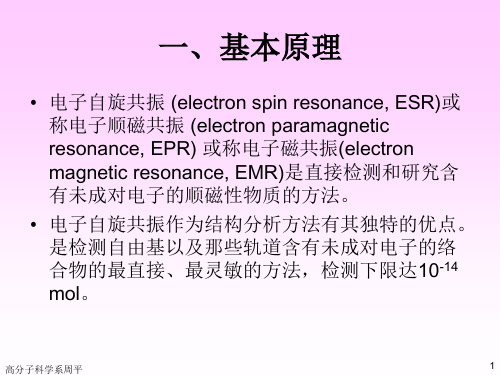
– 物质的顺磁性是由分子的永久磁矩引起的。
高分子科学系周平
2
一、基本原理
• 1、电子自旋共振的产生
• 电子自旋共振(ESR)或电子磁共振(EMR)与 核磁共振(NMR)在量子力学原理上有许多相似 之处,都是由于粒子在静态磁场中角动量能级发 生分裂,从而造成低能态与高能态粒子的布居数 不同,之后,在另外一个电磁波的共振激发下吸 收能量,使布居数达到平均,因此而产生共振信 号。
• 3、应用举例 • 高分子材料的ESR谱
• ESR能够有效检测聚合物聚集态的 分子运动和微观结构。
• 将一种含稳定自由基的探针化合物 TOMPOL在聚氨酯(PU)及其与不同 含量的苄基淀粉(BS)反应时加入,由 此形成的材料PUL以及半互穿网络聚 合物UBS20L和UBS50L的ESR在低 温时呈宽谱,说明TOMPOL运动缓慢, 而随温度升高,峰型变窄,说明分子 运动加快。峰宽值Azz随温度变化曲 线如图所示,峰宽变化50%的温度分 别为67, 62和55C,与玻璃化转变温 度对应。说明随BS的加入,降低了 PU网络的交联密度,PU分子上的
hυ=gβH
则处于低能级的电子吸收此微波而发生受 激跃迁,并产生电子自旋共振波谱。
高分子科学系周平
7
一、基本原理
• 1、电子自旋共振的产生
高分子科学系周平
8
一、基本原理
• 1、电子自旋共振的产生
• 由于电子质量比核质量小得多(< 103倍),根据测不准原理,运 动速度越快的粒子,吸收线形越宽。因此,ESR 吸收信号的 线宽较 NMR 信号宽得多 (> 103倍!),一般ESR谱用磁场调 制系统使输出线型呈一次微分图,并用相敏检测,以提高分辨 率,滤除噪音信号。
模板法制备α-MoO_3纳米棒和纳米矩形片及光谱表征
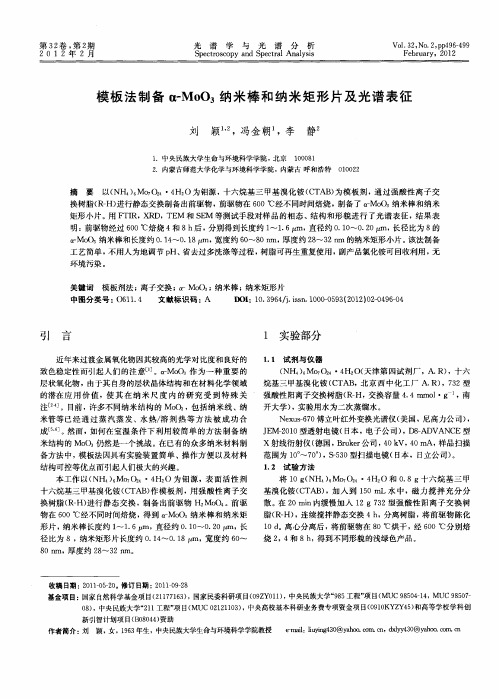
1 实验部分
11 试 剂 与 仪 器 .
( NH46 7 2 4 0( )Mo0 4・ H2 天津第 四试剂 厂,A. ,十六 R) 烷基三 甲基溴化 铵 ( TA C B,北京西 中化 工厂 A. ,7 2型 R) 3
到溶液 中, 使溶液 酸度增 大 ,当体 系 p 约为 1时 ,开始 均 H
匀地 析出 H Mo 4 O 沉淀 。 z O 在模板剂 ( T B 胶 束 中 H Mo 4 CA )
成核 ,聚集 为小颗 粒 ,由于 C TAB胶 束为棒 状结构 ,因此小
颗粒有序排列 , C AB胶束 软模板 的诱导作用 下 , 颗粒 在 T 小 沿某方 向有序生长 。 1 经 0d的陈化 , 前驱物在 C AB胶束 中 T 充分发育完善成较 大 Hz O Mo 4颗粒 , 经过 6 0℃焙烧 2h 再 0 以上 , 模板 剂分 解 为 NH r O B ,C 2和 Hz O,这 三 种 产物 在 6 0℃挥 发 , 0 最终体 系 自组装成 Mo 纳米棒和矩形小片 。 O3
00 , . 8 效果较好 , 备 出的产物 纯度 高 , 杂 质 ,产物 的形 制 无
状规则完美 。
2 3 焙 烧 温 度 和 时 间对 样 品 形 貌 的影 响 .
舞
实验 发现 ,反 应 的前 驱物 陈化 1 0 d后 ,分别 经 5 0和 0 5 0℃焙烧 3h 样 品不形 成完 整的棒状 , 5 , 且未能完全 除掉模 板剂 ,仍为较深 的灰色 , 明有残 留碳 附着在模 板剂 上。当 表 在 60℃焙烧 2h后 ,可以完全 除掉模 板剂 ,基本 形成纳米 0 棒 ,但还不够完善 [ 3 a] 图 () 。在 60℃ 焙烧 4h后 ,得到 浅 0 绿色 、表面光滑和较完美 的 Mo 纳 米棒 [ 3 b ] O3 图 ( ) 。在 6 0 0
气溶胶颗粒物物貌特征、分类及辨别方法
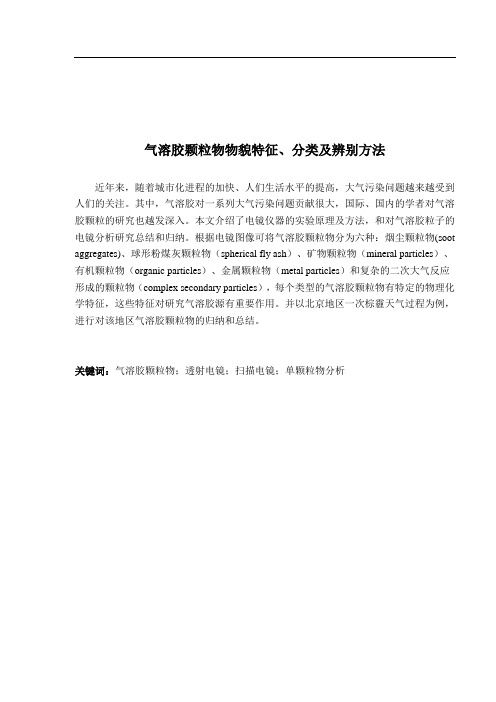
气溶胶颗粒物物貌特征、分类及辨别方法近年来,随着城市化进程的加快、人们生活水平的提高,大气污染问题越来越受到人们的关注。
其中,气溶胶对一系列大气污染问题贡献很大,国际、国内的学者对气溶胶颗粒的研究也越发深入。
本文介绍了电镜仪器的实验原理及方法,和对气溶胶粒子的电镜分析研究总结和归纳。
根据电镜图像可将气溶胶颗粒物分为六种:烟尘颗粒物(soot aggregates)、球形粉煤灰颗粒物(spherical fly ash)、矿物颗粒物(mineral particles)、有机颗粒物(organic particles)、金属颗粒物(metal particles)和复杂的二次大气反应形成的颗粒物(complex secondary particles),每个类型的气溶胶颗粒物有特定的物理化学特征,这些特征对研究气溶胶源有重要作用。
并以北京地区一次棕霾天气过程为例,进行对该地区气溶胶颗粒物的归纳和总结。
关键词:气溶胶颗粒物;透射电镜;扫描电镜;单颗粒物分析第一章引言气溶胶,又称气胶、烟雾质,是指固体或液体微粒稳定地悬浮于气体介质中形成的分散体系。
它可以吸收和散射辐射,从而影响气候。
也可以成为凝结核,从而影响降水。
气溶胶可分为人为和自然两种来源类型。
其中,人为因素引起的排放,如工业废气、机动车尾气和大量燃煤供暖,也随之加大。
随着社会经济的快速发展,生活水平的快速提高,人们越来越关注环境问题。
而最近的研究表明,一些气溶胶颗粒物也可进入人的呼吸道,对人们的健康产生影响。
大气颗粒物浓度和呼吸系统以及心肺疾病的住院率、发病率和死亡率呈正相关关系[1]。
中国华北地区出现的许多次大规模雾霾现象,已经对人们的生活产生了重大影响,也得到了很多专家学者的关注。
因此,对大气中各种气溶胶的分类以及成分的研究必不可少。
气溶胶单颗粒分析的方法已经在大气气溶胶颗粒研究的各领域得到广泛应用,在大气颗粒物气候效应、生态效应、环境效应、颗粒物源解析、大气颗粒物化学反应过程等方面的研究已经有不少的成果[2]。
位错三维表征技术

部畸变会造成 X 射线相位发生变化, 利用迭代相位重建
位错的 三 维 应 变 场。 BCDI 技 术 无 需 使 用 衍 射 光 学 元
等缺陷的形貌 [38] 。 基于同步辐射 X 射线的位错三维表征
一技术可以在大于 180°倾转范围内收集衍射信息, 能够
泛的方法之一。 X 射线穿透晶体材料时, 晶体内部的局
技术特别是基于 TEM 的位错三维表征技术未来的发展趋
判断位错之间是否相交, 采用衍衬分析方法确定的柏氏
势和技术特点进行了展望。
矢量等位错晶体学信息无法与其空间几何信息相耦合,
图 1 不同尺度上位错的表征方法: ( a) 表面法光镜成像 [2] , ( b) 缀饰法光镜成像 [3] , ( c) X 射线成像 [2] , ( d) 扫描电子显微镜-电子
[6]
, 可
( 图 1) 。 然而, 采用上述表征 方 法 所 得 到 的 位 错 图 像,
ion beam-electron channeling contrast imaging, FIB-ECCI) 系
应用实例, 对比讨论上述重构技术在分辨率、 定量表征
或者是位错与样品表面的截面图像, 或者是位错结构在
滑移面和滑移方向等; ③ 能量参量, 如位错位移场、 应
418
第 40 卷
中国材料进展
力 / 应变场、 核芯能和弹性应变能及其空间分布等。 参量
这些局限性在很大程度上限制了人们对于众多位错相关
的多样性、 关联性和复杂性深刻影响着位错的形态和空
科学现象和规律的准确认识。 因此, 开发先进的位错多
间组态特征, 同时深刻影响着外场作用下位错的动态行
(2. Electron Microscopy Center, Chongqing University, Chongqing 400044, China)
物理名词英文缩写

序号缩写英文全称1AFM antiferromagnetic2MIT metal-to-insulator transition3SQUID superconducting quantum interference device 4MPMS Physical Property Measurement System5Shimadzu6XRD X-Ray DiffractionX-Ray Powder Diffraction)7XRPD8FC field-cooled9ZFC zero field-cooled10spin gap systems11spin-Peierls transition12ESR Electron spin resonance13LIESST light induced excited spin state trapping14LITH light induced thermal hysteresis15SCO spin crossover16IR spectrum Infrared Radiation spectrum17TEM transmission electron microscope (TEM)18FTIR Fourier Transform Infrared Spectroscopy19DSC Differential scanning calorimetry20DSC Dynamic Stability Control21MPMS Physical Property Measurement System22MBE Molecular Beam Epitaxy23MOKE magneto-optical Kerr effect24XPS X-ray photoelectron spectroscopy analysis)25TEM Transmission electron microscope26LIBs laser induced breakdown spectroscopy27282930313233343536373839中文意思具体意思反铁磁的金属和绝缘体之间的转换量子扰动超导探测器磁学测量系统分光光度计X射线衍射X射线粉末衍射加场冷却零场冷却自旋能隙系统派尔斯自旋跃迁电子自旋共振光致激发自旋俘获光致热磁滞现象自旋交叉自旋交叉是第一行d—金属(第三周期电子结构为d4-d7过渡金属)配合物在一定条件的作用下由高自旋转换为低自旋,或者由低自旋转换为高自旋。
210984055_WC_颗粒熔解析出对Ni60_熔覆层性能的影响

第52卷第3期表面技术2023年3月SURFACE TECHNOLOGY·189·WC颗粒熔解析出对Ni60熔覆层性能的影响芦海俊1,水剑虹2,王锴1,尚勇1,姜海峰1,魏金1(1.中铁工程装备集团隧道设备制造有限公司,河南 新乡 453011;2.中国水利水电第十一工程局有限公司,河南 三门峡 450001)摘要:目的确定含WC微粒镍基熔覆层中不同共晶相对熔覆层性能的影响规律。
方法通过等离子工艺制备含WC(质量分数10%)的Ni60熔覆层,并调整电流,以控制WC的熔解析出。
通过维氏硬度计、剪切试验、磨粒磨损试验研究不同电流下熔覆层硬度、抗剪强度和耐磨性的变化情况,并通过扫描电镜和X射线衍射仪分析不同熔覆层的磨损形貌、组织和物相组成。
结果在不同电流下制备的熔覆层物相均主要为γ−(Fe,Ni)、M23C6、M7C3、WC、W2C、FeNi3、FeW2B2等。
熔覆电流由110 A增至200 A时,熔覆层的硬度由846.7HV降至665.8HV,抗剪强度由174.9 MPa增至373.2 MPa。
当电流低于140 A时,W、Cr、C等合金元素生成了块状先共晶相,可有效减轻磨粒磨损程度,提高耐磨性;当电流进一步增大时,W、Cr、C等合金元素以鱼骨状过共晶相析出,在磨粒磨损过程中易断裂、脱落,导致耐磨性下降。
结论熔覆电流的变化会影响含WC微粒Ni60熔覆层的共晶碳化物成分、形态和数量,在熔覆电流较小时有利于块状先共晶相的生成,可提高其耐磨性。
在熔覆电流为140 A时,Ni60+WC(10%)熔覆层的综合性能最优。
关键词:WC;Ni60;抗剪强度;磨粒磨损;熔覆电流中图分类号:TG174.44 文献标识码:A 文章编号:1001-3660(2023)03-0189-08DOI:10.16490/ki.issn.1001-3660.2023.03.016Effects of Dissolving and Precipitating of WC Particleson Performance of Ni60 CoatingLU Hai-jun1, SHUI Jian-hong2, WANG Kai1, SHANG Yong1, JIANG Hai-feng1, WEI Jin1(1. China Railway Engineering Equipment Group Tunnel Equipment Manufacturing Co., Ltd., Henan Xinxiang 453011, China;2. Sinohydro Bureau 11 Co., Ltd., Henan Sanmenxia 450001, China)ABSTRACT: The Ni60 coatings containing WC particles have been widely used because of its excellent performance. The effects of preparation technology, size and content of WC particles on performance of Ni60 coatings are in-depth studied, but the effects of different eutectic carbides generated during cladding are not so clear. The work aims to study the effects of收稿日期:2022–03–14;修订日期:2022–09–08Received:2022-03-14;Revised:2022-09-08基金项目:河南省科技攻关重点项目(202102210210);中铁高新工业股份有限公司科技开发计划(2021−10);中铁工程装备集团隧道设备制造有限公司科研项目(2021−KY018)Fund:Key Science and Technology Program of Henan Province, China (202102210210); Science and Technology Development Plan of China Railway Hi-Tech Industry Corporation Limited (2021-10); Research Project of China Railway Engineering Equipment Tunnel Equipment Manufacturing Co., Ltd. (2021-KY018)作者简介:芦海俊(1990—),男,硕士,主要研究方向为耐磨材料。
Electrondiffract...
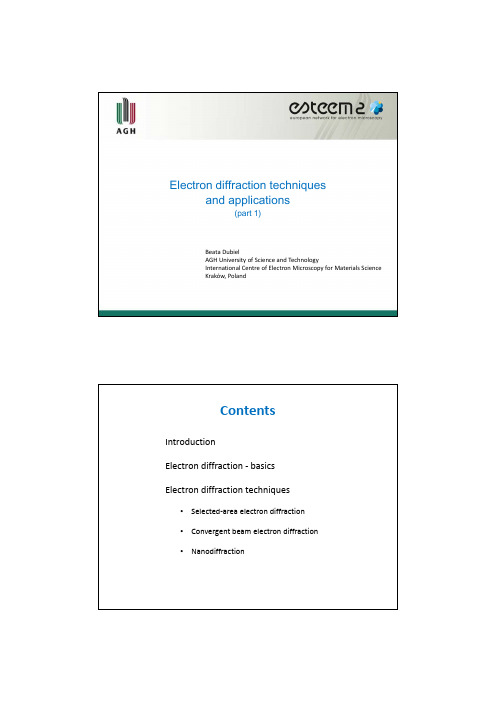
Electron diffraction techniquesand applications(part 1)Beata DubielAGH University of Science and TechnologyInternational Centre of Electron Microscopy for Materials ScienceKraków, PolandContentsIntroductionElectron diffraction‐basicsElectron diffraction techniques•Selected‐area electron diffraction•Convergent beam electron diffraction•Nanodiffractionamorphous carbon Al single crystalpolycrystalline Au convergent beam electron diffraction“Transmission Electron Microscopy”, Williams“Transmission Electron Microscopy”, Williams Scattering from a plane of atomsWW“Transmission Electronincident wavefront normaldiffracted wave normaldifference vector (= k D –k I)k Iat the Bragg angle|K|= |K B|= g“Transmission Electron Microscopy”, Williams & Carter, SpringerThe Bragg description of diffraction in terms of the reflection of a plane wave (wavelength l)incident at an angleθto atomic planes of spacing d.The path difference between reflected waves is AB+BC.“Transmission Electron Microscopy”, Williams & Carter, Springer“Transmissionin the direction of the diffracted beam from all points shown will be in phase if 2d sinθ= nλ“Transmission Electronset of planes a distance d apart.oriented in the Bragg diffracting condition.are labeled G, 2G, etc.the origin (O) to the first diffraction spot G is normal to the“Transmission Electron Microscopy”,denotes the cross product between two vectors volume of the unit cell:/resources/4111/download/2008.02.20‐mse640‐l4.pdf /~che241/y3‐2002/2009lec19.pptk–k0= g + scuts the reciprocal‐lattice point, the Bragg condition isdiffraction: radius of sphere is very large compared to reciprocal circumference is almost flat.…Principles and practice of electron diffraction”,rods(relrods)…Principles and practice of electron diffraction”, Duncan Alexander, EPFL 2010“Transmission Electron Microscopy”, Williams & Carter, Springer 2009cuts relrodsEwald sphere cuts a relrod,we still see a diffraction spot,condition is not satisfied.…Principles and practice of electron diffraction”,sphere interceptsnegative value of sThe intensity of the diffracted beamof where the Ewald sphere cuts“Transmission Electron Microscopy”,A[011][200][311][111][022]Zone axis DP, [011] beam directionSurroundingserieskinematical and dynamical…Principles and practice of electron diffraction”, Duncan Alexander, EPFL 2010area electron diffractionthe area if the beams do not traveldue to spherical aberration in the objectiveposition for a perfect lens and C is the spot“Transmission ElectronTypes of SAED patternsSingle crystalSmall number of grainsLarge number of randomly oriented …Electron microscopy and microanalysis”, Goodhew et al., Taylor & Francis 2001amorphous carbon0.5 μm [110]A A matrixtwindouble common 2111100211211000b011b 1101Orientation 200 nmγ’γ{100}γ//{100}γ’ 〈010〉γ// 〈010〉γ’[001]γ// [001]γ’Dark‐field image in (011)γ’’1 0 0 n m 2 0 0 n m[100]γ[100] γ"[010] γ"[001] γ" Crystallographically oriented precipitatesRing diffraction patternsIf selected area aperture selects numerous, randomly‐oriented nanocrystals,SAED pattern consists of rings from all possible diffracting planes, like powder X‐ray diffractionExample: nanocrystalline nickel‐base superalloy500 nm100 nmKikuchi linesdiffracted because they travel at the Bragg electrons form Kossel cones centered at to the incident beam direction are dark (deficient)bright (excess).“Transmission Kikuchi lines“Transmission Electron the Ewald sphere, creating parabolas which approximate because B is small.SAEDCBEDexact Bragg condition(2h2k2l) spot strongly excited(3h3k3l) spot strongly excited the excess Kikuchi at(hkl)“Transmission Electron Microscopy”, Williams & Carter,Pair of Kikuchi linesExperimental Kikuchi map for fcc crystalsand indexed Kikuchi lines in the schematic map“Transmission Electron Microscopy”, Williams & Carter, Springer 2009diffractionconverged illumination“Transmission Electron Microscopy”,“Transmission Electron Microscopy”, Williams & Carter, Springer Thickness determination using CBED000112••Bragg and HOLZ lines superimposed defocus image are used for:‐Burgers vector analysis:splitting of by dislocations‐orientation relationships:lines continuous/discontinuous across interfacesNanodiffractionNanodiffraction(nano‐beam diffraction) =Imaging the condenser aperture using a third condenser lensgives the nanometer‐sized beam with parallel illuminationZuo et al. Microscopy Research and Technique 64 347Nanodiffraction patterns from a multi‐walled carbon nanotube“Transmission Electron。
纳米材料的表征方法(1)
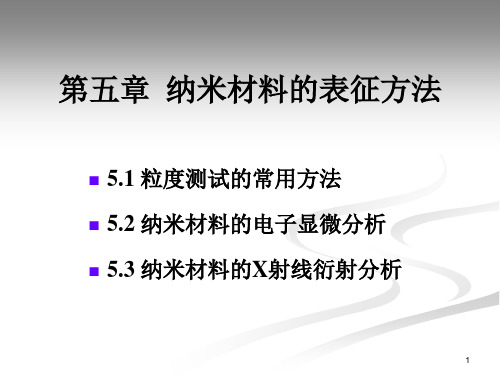
煤灰/硫化物混合颗粒的TEM图象
Sol-gel法合成羟磷灰石, 可分辨出毛发状、长柱状的晶体 轮廓, 但晶面发育不明显 (TEI)
(a) (b)
❖5.2.3 扫描电镜(Scanning Electronic Microscopy, SEM)
❖JSM-6301F场发射扫描电镜
❖SEM image (beetle)
5.1.2. 粒度测试的常用方法
传统方法:显微镜法(0.8-150μm用光学显微镜,小于0.8微
米用电子显微镜)、筛分法、沉降法、电感应法
新发展的方法:激光衍射法、激光散射法、光子相干光谱法
(1nm-5μm)、电超声粒度分析法(5nm-100μm)、电子显 微镜图像法、基于颗粒布朗运动的粒度测量和质谱法、激 光粒度分析法
Bi-系超导氧化物的堆积缺陷层调整 Stacking fault Layer modulation
Electron Diffraction Pattern
晶体
多晶体
非晶体
一、成像原理
透射电子显微镜中,物镜、中间镜,总的放大倍 数就是各个透镜倍率的乘积。
M = M0.Mi.Mp
透镜的成像作用可以分为两个过程: 第一个过程是平行电子束遭到物的散射作用而分裂成为
TEM简介:
高分辨电镜(HRTEM)
透射扫描电镜(STEM)
分析型电镜(AEM)等等。
入射电子束(照明束)也有两种主要形式:
平行束:透射电镜成像及衍射
会聚束:扫描透射电镜成像、微分析及微衍射
透射电子显微镜由三大部分组成: 电子光学系统、真空系统、供电控制系统。
JEM-2010透射电镜
5.2 纳米材料的电子显微分析
5.2.1 电子显微镜
材料英语词汇

材料英语词汇专业词汇列表晶体结构(structure of crystal)原子质量单位Atomic mass unit (amu)原子量Atomic weight键能Bonding energy共价键Covalent bond电子构型electronic configuration正电的Electropositive氢键Hydrogen bond同位素Isotope摩尔Mole泡利不相容原理Pauli exclusion principle原子atom分子量molecule weight量子数quantum number范德华键van der waals bond点群point group波尔原子模型Bohr atomic model库仑力Coulombic force分子的构型molecular configuration负电的Electronegative基态Ground state离子键Ionic bond金属键Metallic bond分子Molecule元素周期表Periodic table极性分子Polar molecule价电子valence electron电子轨道electron orbitals对称要素symmetry elements原子堆积因数atomic packing factor(APF)面心立方结构face-centered cubic (FCC)配位数coordination number晶系crystal system衍射diffraction电子衍射electron diffraction六方密堆积hexagonal close-packed (HCP)NaCl型结构NaCl-type structure闪锌矿型结构Blende-type structure金红石型结构Rutile structure钙钛矿型结构Perovskite-type structure硅酸盐结构Structure of silicates链状结构Chain structure架状结构Framework structure叶蜡石pyrophyllite石英quartz美橄榄石forsterite各向异性的anisotropy晶格参数lattice parameters非结晶的noncrystalline多晶形polymorphism单晶single crystal电位electron states电子electrons金属键metallic bonding极性分子polar molecules衍射角diffraction angle粒度,晶粒大小grain size显微照相photomicrograph透射电子显微镜transmission electron microscope (TEM)四方的tetragonal配位数coordination number 晶胞unit cell(化合)价valence共价键covalent bonding离子键Ionic bonding 原子面密度atomic planar density合金alloy显微结构microstructure扫描电子显微镜scanning electron microscope (SEM)重量百分数weight percent单斜的monoclinic 晶体结构缺陷(defect of crystal structure)缺陷defect, imperfection线缺陷line defect, dislocation体缺陷volume defect位错线dislocation line螺位错screw dislocation晶界grain boundaries小角度晶界tilt boundary,位错阵列dislocation array位错轴dislocation axis位错爬移dislocation climb位错滑移dislocation slip位错裂纹dislocation crack位错密度dislocation density间隙原子interstitial atom间隙位置interstitial sites弗伦克尔缺陷Frenkel disorder主晶相the host lattice缔合中心Associated Centers.电子空穴Electron Holes克罗各-明克符号Kroger Vink notation固溶体solid solution化合物compound置换固溶体substitutional solid solution不混溶固溶体immiscible solid solution有序固溶体ordered solid solution固溶强化solid solution strengthening点缺陷point defect面缺陷interface defect位错排列dislocation arrangement刃位错edge dislocation混合位错mixed dislocation大角度晶界high-angle grain boundaries孪晶界twin boundaries位错气团dislocation atmosphere位错胞dislocation cell位错聚结dislocation coalescence位错核心能量dislocation core energy位错阻尼dislocation damping原子错位substitution of a wrong atom晶格空位vacant lattice sites杂质impurities肖脱基缺陷Schottky disorder错位原子misplaced atoms自由电子Free Electrons伯格斯矢量Burgers中性原子neutral atom固溶度solid solubility间隙固溶体interstitial solid solution金属间化合物intermetallics转熔型固溶体peritectic solid solution无序固溶体disordered solid solution取代型固溶体Substitutional solid solutions过饱和固溶体supersaturated solid solution非化学计量化合物Nonstoichiometric compound表面结构与性质(structure and property of surface)表面surface同相界面homophase boundary晶界grain boundary小角度晶界low angle grain boundary共格孪晶界coherent twin boundary 错配度mismatch重构reconstuction表面能surface energy扭转晶界twist grain boundary共格界面coherent boundary非共格界面noncoherent boundary 应变能strain energy惯习面habit plane界面interface异相界面heterophase boundary表面能surface energy大角度晶界high angle grain boundary晶界迁移grain boundary migration驰豫relaxation表面吸附surface adsorption倾转晶界titlt grain boundary倒易密度reciprocal density半共格界面semi-coherent boundary界面能interfacial free energy晶体学取向关系crystallographic orientation非晶态结构与性质(structure and property ofuncrystalline)熔体结构structure of melt玻璃态vitreous state粘度viscosity介稳态过渡相metastable phase淬火quenching玻璃分相phase separation in glasses 过冷液体supercooling melt软化温度softening temperature表面张力Surface tension组织constitution退火的softened体积收缩volume shrinkage扩散(diffusion)活化能activation energy浓度梯度concentration gradient 菲克第二定律Fick’s second law 稳态扩散steady state diffusion扩散系数diffusion coefficient填隙机制interstitalcy mechanism 短路扩散short-circuit diffusion 下坡扩散Downhill diffusion扩散通量diffusion flux菲克第一定律Fick’s first law相关因子correlation factor非稳态扩散nonsteady-state diffusion 跳动几率jump frequency晶界扩散grain boundary diffusion 上坡扩散uphill diffusion互扩散系数Mutual diffusion渗碳剂carburizing浓度分布曲线concentration profile 驱动力driving force自扩散self-diffusion空位扩散vacancy diffusion扩散方程diffusion equation扩散特性diffusion property达肯方程Dark equation本征热缺陷Intrinsic thermal defect 离子电导率Ion-conductivity浓度梯度concentration gradient扩散流量diffusion flux间隙扩散interstitial diffusion表面扩散surface diffusion扩散偶diffusion couple扩散机理diffusion mechanism无规行走Random walk柯肯达尔效应Kirkendall equation本征扩散系数Intrinsic diffusion coefficient 空位机制Vacancy concentration腐蚀与氧化(corroding and oxidation)氧化反应Oxidation reaction还原反应Reduction reaction价电子Valence electron腐蚀介质Corroding solution电动势Electric potential推动力The driving force腐蚀系统Corroding system腐蚀速度Corrosion penetration rate 电流密度Current density电化学反应Electrochemical reaction 极化作用Polarization过电位The over voltage浓差极化Concentration polarization 电化学极化Activation polarization 极化曲线Polarization curve缓蚀剂Inhibitor原电池galvanic cell电偶腐蚀galvanic corrosion 电位序galvanic series应力腐蚀Stress corrosion冲蚀Erosion-corrosion腐蚀短裂Corrosion cracking 防腐剂Corrosion remover腐蚀电极Corrosion target隙间腐蚀Crevice corrosion 均匀腐蚀Uniform attack晶间腐蚀Intergranular corrosion焊缝破坏Weld decay选择性析出Selective leaching氢脆损坏Hydrogen embitterment阴极保护Catholic protection穿晶断裂Intergranular fracture固相反应和烧结(solid state reaction and sintering)固相反应solid state reaction烧成fire再结晶Recrystallization成核nucleation子晶,雏晶matted crystal异质核化heterogeneous nucleation铁碳合金iron-carbon alloy铁素体ferrite共晶反应eutectic reaction烧结sintering合金alloy二次再结晶Secondary recrystallization结晶crystallization耔晶取向seed orientation均匀化热处理homogenization heat treatment渗碳体cementite奥氏体austenite固溶处理solution heat treatment相变(phase transformation)过冷supercooling晶核nucleus形核功nucleation energy均匀形核homogeneous nucleation形核率nucleation rate热力学函数thermodynamics function 临界晶核critical nucleus枝晶偏析dendritic segregation平衡分配系数equilibrium distribution coefficient成分过冷constitutional supercooling共晶组织eutectic structure伪共晶pseudoeutectic表面等轴晶区chill zone中心等轴晶区equiaxed crystal zone急冷技术splatcooling单晶提拉法Czochralski method位错形核dislocation nucleation斯宾那多分解spinodal decomposition马氏体相变martensite phase transformation 成核机理nucleation mechanism过冷度degree of supercooling形核nucleation晶体长大crystal growth非均匀形核heterogeneous nucleation长大速率growth rate临界晶核半径critical nucleus radius局部平衡localized equilibrium有效分配系数effective distribution coefficient引领(领先)相leading phase层状共晶体lamellar eutectic离异共晶divorsed eutectic柱状晶区columnar zone定向凝固unidirectional solidification区域提纯zone refining晶界形核boundary nucleation晶核长大nuclei growth有序无序转变disordered-order transition 马氏体martensite成核势垒nucleation barrier相平衡与相图(Phase equilibrium and Phase diagrams)相图phase diagrams组分component相律Phase rule浓度三角形Concentration triangle成分composition相平衡phase equilibrium热力学thermodynamics吉布斯相律Gibbs phase rule吉布斯自由能Gibbs free energy吉布斯熵Gibbs entropy热力学函数thermodynamics function 过冷supercooling杠杆定律lever rule相界线phase boundary line共轭线conjugate lines相界反应phase boundary reaction相组成phase composition金相相组织phase constentuent相衬显微镜phase contrast microscope 相分布phase distribution相平衡图phase equilibrium diagram相分离phase segregation相phase组元compoonent投影图Projection drawing冷却曲线Cooling curve自由度freedom化学势chemical potential相律phase rule自由能free energy吉布斯混合能Gibbs energy of mixing 吉布斯函数Gibbs function热分析thermal analysis过冷度degree of supercooling相界phase boundary相界交联phase boundary crosslinking相界有限交联phase boundary crosslinking 相变phase change共格相phase-coherent相衬phase contrast相衬显微术phase contrast microscopy相平衡常数phase equilibrium constant相变滞后phase transition lag相序phase order相稳定性phase stability相稳定区phase stabile range相变压力phase transition pressure同素异晶转变allotropic transformation显微结构microstructures不混溶性immiscibility相态phase state相变温度phase transition temperature同质多晶转变polymorphic transformation 相平衡条件phase equilibrium conditions。
ENiCrFe-3、ENiCrMo-3镍基合金异种钢焊缝力学性能研究

ENiCrFe-3、ENiCrMo-3镍基合金异种钢焊缝力学性能研究◎谢新苗1刘雁2杨易坤1(作者单位:1.一重集团大连核电石化有限公司;2.利勃海尔机械(大连)有限公司)一、引言石油化工压力容器制造的过程中,经常遇到异种钢焊接结构,由于异种钢焊接时存在焊缝合金成分与基材成分的差异,受基材厚度、焊缝结构、焊接参数等因素影响,母材熔化区域和熔敷金属的互相稀释作用将发生变化,造成焊接接头部位的成分、组织和性能严重不均匀,影响焊接接头质量。
而且在异种钢焊接过程中,不同材质的钢材膨胀系数及导热性能均存在一定的差异,使得焊接接头出现残余应力,影响接头性能。
为解决以上问题,由于镍基合金可消除脱碳层及其良好的塑形,现经常将镍基合金应用到异种钢焊接工艺中,可以有效的避免焊缝金属稀释以及化学成分改变所带来的影响,对接头部位的稳定性及焊接质量均可带来明显的提升。
ENiCrFe3、ENiCrMo3是常用于异种钢对接的镍基合金焊材类别,如某压力容器的低合金钢筒节与不锈钢接管焊接接头(见图1),该接头基材金属有15CrMoR、S32168、S30403,焊接接头成分将更加复杂,因此该接头采用了先堆焊ENiCrFe3合金隔离层,之后继续用ENiCrFe3焊接坡口的接头型式。
ENiCrFe3、ENiCrMo3镍基合金均为固溶强化镍基合金,虽然固溶在焊态下的力学性能常常是足够的,但有时为了消除残余应力、降低氢含量或均匀显微组织,镍基合金焊缝会经历焊后热处理[3]。
为确认和对比ENiCrFe3、ENiCrMo3镍基合金的焊接性能及焊后热处理对焊缝性能的影响,现通过两组焊接试验以期获得镍基全焊缝金属在焊态及模拟焊后热处理态的拉伸性能、冲击性能数据。
图1压力容器异种钢焊接接头型式示例二、焊接试验1.试板准备及焊接。
镍基合金的液相流动性较差,在焊接过程中容易出现小气孔和微小的热裂纹,影响焊接质量。
因此需要选择高质量的镍基合金材料,在焊接期间需控制热输入,选择合适的焊接速度,且堆焊隔离层后进行无损检测,无损检测合格后进行接头焊接。
粒度粒径测试基本知识

等效粒径的种类 及测试方法
? 等效体积径:即与所测颗粒具有相同体积的同质
球形颗粒的直径。激光法所测粒径一般认为是等
效体积径。 ? 等效筛分径 ( 筛分法的粒径 ) ? 等效沉速径 ( 沉淀法的粒径 ) ? 等效投影面积径 ( 显微镜法的粒径 ) ? 等效体积径 ( 光学法的粒径 ) 。
。 准 HG/T3744 云母珠光颜料
缺点 :不宜测量粒度分布很窄的样品,分辨率相对较低。
第十四页,编辑于星期三:二点 二十一分。
激光法应用领域
应用领域包括制药,生物医药,纳米材 料等行业。典型样品:氧化铝 /铜/金钢粉、
半导体、硅盐等无机材料,聚合物乳胶、
乳液、油漆、颜料、药物、甾体等有机体。
第十五页,编辑于星期三:二点 二十一分。
激光法所用的理论
夫琅和 费理论:当颗粒直径比入射波长大得多时发生衍射散射 ,
这时由夫琅禾费衍射理论求得的光强度和米氏散射理论求得的光强度 大体一致 ,但前者计算过程较简便 ,因此当 D > >λ时用夫琅禾费衍射理
论作为散射理论的近似处理 。
米氏理论:
当颗粒粒径小于等于波长时,就必须使用米氏
理论了。 Mie理论是描述散射现象的严格理论,因此许多国外仪器和
粒子的布朗运动导致光强的波动 当光束遇到颗粒阻挡时,一部分光将发生散射现象。散射光的传播方向 将与主光束的传播方向形成一个夹角。颗粒越大,产生的散射光的 θ角就越小; 颗粒越小,产生的散射光的 θ角就越大。散射光的强度代表该粒径颗粒的数量。 这样,在不同的角度上测量散射光的强度,就可以得到样品的粒度分布了。
仪器原理不同,一般来说测试结果
是不同的。只有当颗粒是球形时,不
透射电镜的选区电子衍射

透射电子显微镜的选区衍射摘要:本文主要是以透射电子显微镜的选区电子衍射为主题来说明透射电镜在材料学中的应用。
关键词:透射电镜;电子衍射谱;选区电子衍射;应用Selected-Area Electron Diffraction of TEMAbstract: The Selected-Area Electron Diffraction of TEM is mainly talked about in this paper, And it tell us the application of the TEM in materials science.Key words:Transmission electron microscope; Electron diffraction spectrum; Selected-Area Electron Diffraction; application1.透射电镜的电子衍射概论透射电镜的电子衍射是透射电镜的一个重要应用,而透射电镜广泛应用于断裂失效分析、产品缺陷原因分析、镀层结构和厚度分析、涂料层次与厚度分析、材料表面磨损和腐蚀分析、耐火材料的结构与蚀损分析[1]中。
透射电镜的电子衍射能够在同一试样上将形貌观察与结构分析结合起来[2]。
这就使得电子衍射在应用中有着举足轻重的地位。
在透射电镜的衍射花样中,对于不同的试样,采用不同的衍射方式时,可以观察到多种形式的衍射结果。
如单晶电子衍射花样,多晶电子衍射花样,非晶电子衍射花样,会聚束电子衍射花样,菊池花样等。
而且由于晶体本身的结构特点也会在电子衍射花样中体现出来,如有序相的电子衍射花样会具有其本身的特点。
另外,由于二次衍射等原因会使电子衍射花样变得更加复杂。
选区衍射的特点是能把晶体试样的像与衍射图对照进行分析,从而得出有用的晶体学数据,例如微小沉淀相的结构、取向及惯习面,各种晶体缺陷的几何学特征等[3]。
2.选区电子衍射的原理及特点2.1选区电子衍射的原理为了得到晶体中某一个微区的电子衍射花样,一般用选区衍射的方法,将选区光阑放置在物镜像平面(中间镜成像模式时的物平面),而不是直接放在样品处。
射频磁控反应溅射低温制备高C轴择优取向的氮化铝薄膜
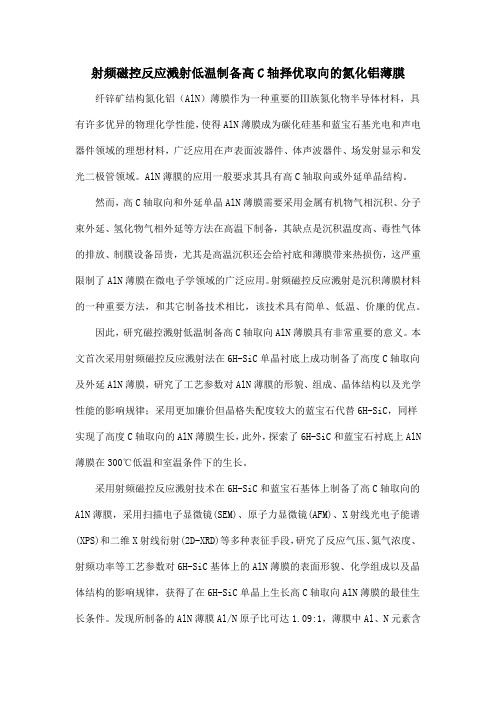
射频磁控反应溅射低温制备高C轴择优取向的氮化铝薄膜纤锌矿结构氮化铝(AlN)薄膜作为一种重要的Ⅲ族氮化物半导体材料,具有许多优异的物理化学性能,使得AlN薄膜成为碳化硅基和蓝宝石基光电和声电器件领域的理想材料,广泛应用在声表面波器件、体声波器件、场发射显示和发光二极管领域。
AlN薄膜的应用一般要求其具有高C轴取向或外延单晶结构。
然而,高C轴取向和外延单晶AlN薄膜需要采用金属有机物气相沉积、分子束外延、氢化物气相外延等方法在高温下制备,其缺点是沉积温度高、毒性气体的排放、制膜设备昂贵,尤其是高温沉积还会给衬底和薄膜带来热损伤,这严重限制了AlN薄膜在微电子学领域的广泛应用。
射频磁控反应溅射是沉积薄膜材料的一种重要方法,和其它制备技术相比,该技术具有简单、低温、价廉的优点。
因此,研究磁控溅射低温制备高C轴取向AlN薄膜具有非常重要的意义。
本文首次采用射频磁控反应溅射法在6H-SiC单晶衬底上成功制备了高度C轴取向及外延AlN薄膜,研究了工艺参数对AlN薄膜的形貌、组成、晶体结构以及光学性能的影响规律;采用更加廉价但晶格失配度较大的蓝宝石代替6H-SiC,同样实现了高度C轴取向的AlN薄膜生长,此外,探索了6H-SiC和蓝宝石衬底上AlN 薄膜在300℃低温和室温条件下的生长。
采用射频磁控反应溅射技术在6H-SiC和蓝宝石基体上制备了高C轴取向的AlN薄膜,采用扫描电子显微镜(SEM)、原子力显微镜(AFM)、X射线光电子能谱(XPS)和二维X射线衍射(2D-XRD)等多种表征手段,研究了反应气压、氮气浓度、射频功率等工艺参数对6H-SiC基体上的AlN薄膜的表面形貌、化学组成以及晶体结构的影响规律,获得了在6H-SiC单晶上生长高C轴取向AlN薄膜的最佳生长条件。
发现所制备的AlN薄膜Al/N原子比可达1.09:1,薄膜中Al、N元素含量可达96%。
薄膜晶粒尺寸随反应气压和氮气浓度的增加而减小,射频功率在250W表现出最优值,衬底温度增加到500℃后趋于稳定。
- 1、下载文档前请自行甄别文档内容的完整性,平台不提供额外的编辑、内容补充、找答案等附加服务。
- 2、"仅部分预览"的文档,不可在线预览部分如存在完整性等问题,可反馈申请退款(可完整预览的文档不适用该条件!)。
- 3、如文档侵犯您的权益,请联系客服反馈,我们会尽快为您处理(人工客服工作时间:9:00-18:30)。
Electron Diffraction & Phase Contrast 电子衍射像衬度Electron Diffraction倒易点阵倒易点阵与晶体衍射强度TEM中的电子衍射多晶体和单晶体的电子衍射花样 简单电子衍射花样的指数标定电子衍射X射线入射晶体,原子中的电子散射X射线。
每个原子都向四周散射X射线,由于各个原子之间的散射线相互的干涉,只有在满足布拉格条件的那些方向上,才有各个原子散射线的合成光束即,衍射线出现。
电子束在晶体中传播时,受到原子中原子核的散射。
因相干散射而产生衍射,其原理与X射线衍射作用相同,获得的衍射图案相似,且遵从衍射产生的必要条件和系统消光规律。
电子衍射与X射线衍射比较的优势电子束λ短,θ小,入射束、衍射束近乎与衍射晶面平行。
单晶的电子衍射花样可看作晶体的倒易点阵的一个二维截面在底片上放大投影,从底片上的电子衍射花样可以直观地辨认出一些晶体的结构和有关取向关系,使晶体结构的研究比X射线简单。
晶体对电子散射主要是原子核散射,因此散射强,约为X射线一万倍,曝光时间短,适于材料表层或薄膜样品的结构分析。
能够在同一试样上把形貌观察与结构分析结合起来。
(可进行选区衍射)。
电子衍射与X射线衍射比较的劣势电子衍射强度有时几乎与透射束相当,以致两者产生交互作用,使电子衍射花样,特别是强度分析变得复杂,不能象X射线那样从测量衍射强度来广泛的测定结构。
散射强度高导致电子透射能力有限,要求试样薄,这就使试样制备工作较X射线复杂分析精度不如X射线衍射电子衍射按入射电子能量的大小,分为高能电子衍射、低能电子衍射(LEED)。
TEM中的电子衍射属于高能电子衍射。
布拉格定律与倒易点阵正空间(真实空间)中,每一种晶体结构都属于14种布喇菲点阵中的一种。
布喇菲点阵每个结点可代表原子集团或单个原子。
只要晶体属于同一种布喇菲点阵,电子衍射的规律就相同,只是在强度的细节上有差别。
倒易点阵建立在布喇菲点阵的基础上,使衍射研究非常方便。
倒易点阵与衍射现象有着更加密切的关系。
电子衍射斑点与倒易阵点直接对应。
入射电子波PO照射到试样晶面间距为d的晶面族{hkl},OQ为反射波方向。
s为入射波波矢,s为衍射波波矢。
讨论入射波与(hkl)晶面夹角满足布拉格条件时,波矢量间的关系。
讨论相干散射波,电子能量不受损失:| s| = | s| = 1 /λ将矢量s0沿PO方向平移至OO*,则:s -s0= g| s0| = | s|,入射角=反射角=θ,OO*Q等腰三角形QO*┴OE,QE=EO*,所以| g| = 2 | s| sinθ(| s| = 1 /λ)λ= 2 sinθ/ | g|先决条件是入射线与{hk l}晶面之间夹角满足布拉格定律,所以1/ | g| =d d为晶面间距 g是衍射波矢与入射波矢量之差,方向垂直于反射面(hkl),大小等于1/d。
结论:当(hkl)与入射波s0满足Brag条件,则g= s–s0在已知g 和s条件下,可知g所代表的(hkl)晶面是否有反射线出现,如果有其方向也能画出。
布拉格定律与倒易点阵倒易点阵的引入:如果以O*为原点做出许多矢量,每个矢量ghkl都垂直于正点阵相应的晶面,矢量大小为d值的倒数,则矢量端点构成的几何点的空间分布,称倒易点阵,g为倒易矢量。
倒易点阵的建立:以O*为原点,做三个矢量分别垂直于(100)、(010)和(001)晶面,其大小等于1/d100、1/d010和1/d001,这三个矢量为基矢构成的空间作为倒易点阵的单胞,在空间中无限平移,构成倒易空间。
倒易点阵基矢为:a*、b*、c*倒易点阵矢量分析倒易点阵中的常用量:基矢为:a*、b*、c*(uvw)*为倒易点阵中的指数为uvw的点阵面[hkl]*为倒易点阵中的点阵矢量点阵坐标以hkl表示根据上述定义建立的例易点阵倒易阵点坐标hkl的意义?与正点阵有什么关系?从倒易原点到hkl阵点的矢量ghkl 是否代表正点阵的(hkl)晶面? (100)面的面积= b c sinα= | b×c|(010)面的面积= a c sinβ= | c×a|(001)面的面积= a b sinγ= | a×b|设单胞体积为V,则a*= (b×c) / V or a* = b c sinα/ Vb*= (c×a) / V or b* = c a sinβ/ Vc*= (a×b) / V or a* = a b sinγ/ V最一般情况——三斜点阵单胞a≠b≠cα≠β≠γ倒易点阵基矢夹角:α* (b^c) β* (c^a) γ* (a^b)由a*= (b×c) / V or a* = b c sinα/ V 等可得cosα* = b*•c*/ b c= (c×a)•(a×b)/ a2bc sinβsinγ(c×a)•(a×b) = a2bc (cosβcosγ-cosα)所以cosα* = (cosβcosγ-cosα) / sinβsinγ同理cosβ* = (cosγcosα-cosβ) / sinγsinαcosγ* = (cosαcosβ-cosγ) / sinαsinβ倒易点阵单胞的基本参数倒易点阵倒易点阵一般性质:①a*•b= a* •c = b*•a = b*•c= c* •a=c* •b= 0②a*•a= b* •b = c*•c= 1| c*| = 1/ d001c*•c= | c*| | c| cosφ= d001/ d001= 1倒易点阵与正点阵关系根据上述三个基矢定义的倒易单胞无限平移得到的倒易点阵中,坐标为hkl结点的位置矢量ghkl= h a*+ k b*+ l c* ,在倒易空间中hkl结点代表正点阵的(hkl)面。
需证明:①g hkl垂直于正点阵的(hkl)②|g hkl| = 1 / d hkla 1/ h + AB =a 2/ kAB =a 2/ k –a 1/ h在相应倒易点阵中作矢量g hkl = h a *+ k b *+ l c *g •AB = (h a *+ k b *+ l c * ) •(a 2/ k –a 1/ h )= 1 -1= 0所以g 必垂直于ABC 面,即垂直于(hkl )面①g hkl 垂直于正点阵的(hkl )a 1、a 2、a 3为正点阵基矢,三角形ABC 为最靠近原点的(hkl )面,与三个轴的截距为a 1/ h 、a 2/ k 和a 3/ l而n = g / | g |所以d hkl = a / h •g / | g |= a / h •(h a *+ k b *+ l c * )/ | g |= 1/ | g |②|g hkl | = 1 / d hkl令单位矢量n 垂直于(hkl ),则a 1/ h 在n 方向上的投影必等于d hkl ,所以d hkl = a / h •n倒易点阵举例简单立方点阵的倒易点阵:简立方需指出:同为(uvw )*面,必须说明这个面是通过倒易原点的零层面,还是不通过原点的一层,二层…倒易面。
包含101,111,110,100…倒易结点的(100) *面是第一倒易面,表为(100) 1*;包合200,210,211,201…结点的倒易面是第二层(100)*面,用(100)2*表示。
面心立方点阵的倒易点阵:体心立方(体心、面心立方互为倒易)倒易点阵中消光指数(hkl 有奇有偶)不存在,面心亦如此矢量关系:g 200+g 020= g 220亦即:[200]*+ [020]*= [220]*晶带定律与晶体中某一晶向平行的晶面可能有很多,称这些晶面属于同一晶带。
如(100) (010) (110)…(200) (020)(220)…(1-10)…属于[001]晶带;(001) (1-10) (1-11)…属[110]晶带。
令晶带轴方向为r:r= u a +v b +w c属于该晶带的所有晶面都平行于r,代表各晶面的倒易矢量g hkl= h a*+ k b*+ l c*必与r垂直,即g •r= 0 g •r= (h a*+ k b*+ l c*) •(u a +v b +w c)= 0展开得:h u + k v + l w = 0晶带定律属于[001]晶带的晶面所对应的倒易点为200 020 220 2-20…倒易点都处在过原点000与[001]垂直的二维倒易面上。
所以,属于同一晶带的倒易点,一定处于过倒易原点的二维倒易平面上,该二维平面与晶带轴垂直。
晶带轴的确定如果已知过倒易原点的二维倒易面上二个倒易矢量g1和g2,可以确定晶带轴[uvw]令g1= (h1a*+ k1b*+ l1c*)g2= (h2a*+ k2b*+ l2c*)则h1u + k1v + l1w= 0h2u + k2v + l2w= 0只需求出u、v、w之比即可u = k1 l2–l1 k2v = l1h2–h1l2w = h1k2–k1h2与[001]垂直的倒易面中,除零层倒易面外,还有不过原点的第二层、第四层……倒易平面,其倒易矢量不与r垂直。
此时r uvw•g= | r uvw|•| g |cosφ正点阵与倒易点阵互为倒易,所以| r uvw| = 1 / d(uvw)*d(uvw)*应是001011101等构成的面与过原点的面之间的面间距。
第二层面与零层面的面间距为d(uvw)*即| g |cosφ= 2 d(uvw)*r •g= h u + k v + l w= 2所以根据g的端点所处的层数0,1,2,3……h u + k v + l w = N广义晶带轴定律二维倒易面的画法电子衍射斑点的排布与二维倒易面上结点的排布有对应关系。
因此经常需要将电子衍射花样与二维倒易面上斑点分布加以对照,以确定晶带轴和衍射斑点指数。
立方晶系相同晶带二维倒易面上倒易点分布是相同的,有标准图供查。
非立方系的倒易点分布与点阵常数有关,要求根据晶体常数自己画出若干套不同晶带二维倒易面斑点分布,以备使用。
二维倒易面的画法试画出面心立方点阵(-3-2-1)*倒易面上倒易点的分布图,并标出各个点的指数。
①用试探法确定(-3-2-1)*上的某一个倒易点指数h1k1l1。
一般从低指数试起,如取1-1-1,当该点用g1表示时,g1•r= 0,所以1-1-1点一定在(-3-2-1)*面上。
②确定第二个倒易点指数h2k2l2。
可先试是否存在与g1相垂直的g2,如存在则h1h2+ k1k2+ l1l2= 0即h2–k2–l2= 0二维倒易面的画法同时g2•r= 0-3 h2–2 k2-l2= 0联立两方程:h2–k2–l2= 0-3 h2–2 k2-l2= 0可得h2: k2: l2= 1:(-4):5方向:右手规则,g2为r×g1方向。
